#that borders on childish if not for the color scheme
Text
the worst thing (and probably the the thing that spurred my everymanhybrid rewatch) was watching the q&as as background noise a few months ago and realizing i have the same fucking khols button up

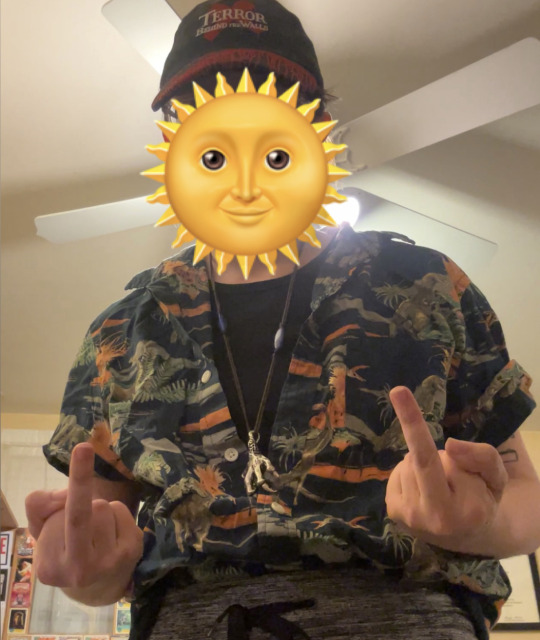
#speakeasies#emh#everymanhybrid#evan emh#yes that blood hat is my deathproof hat equivalent its my signature#ACTUALLY SO EMBARASSING anyway cant wear this shirt in nj anymore!#stop copying meee i say about a video from like 5ish years ago......#what if i ran into him i cant take that CHANCE!!!!!!!!#yeah this probably wont happen but my paranoia takes me lots of places <3#knowing we have the shared experience of going to a fucking khols mens section#seeing a pattern of dinosaurs all over it.#that borders on childish if not for the color scheme#and going holy shit this is gas#and buying it#is very funny
37 notes
·
View notes
Note
what made you fall for chuuya?
LOADED QUESTION
let's go through this step by step

1.) his design. there's so much to talk about there!
One thing I really appreciate about harukawa's costume designs is that despite the series taking place in 2010ish, the main cast's outfits have a very old fashioned vibe. like they're from the mid-20th century. very fitting considering that the bsd world is just recovering from a World War event. So we always get a really interesting mix of different time periods when it comes to the fashion in the series.
So i like the classy, timeless aesthetic of the design as i do with most of the characters but i also appreciate how ... punk it its? Like the gloves, the belts, the tie with the buckle, the hat, the FREAKING CHOKER. let's remember that chuuya was a teenager during the 2000s and then look at the edgier elements of his fancy executive outfit
so many layers! so many accessories!!!!!! there's so much happening here but it doesn't look like too much. But the hat especially, it's a really fun call back to the namesake poet but it's such a good identifiable part, instantly makes his silhouette interesting. The big cape/coat too, and to a lesser extent the gloves and cuffed sleeves are really cool features for his silhouette. shame they got rid of the belt and hat chain for the anime. i'm also a weirdo who finds drawing the hat fun
Overall I like his color palette. i'm a bigbigbig fan of warm tones and red/orange color schemes, and chuuya's is that but darker and muted. very nice to look at. I like his hair especially, I like that its long but not really long like when harukawa draws it. I like that he has a weird haircut. I spent a lot of time staring at it to figure out the mechanics of it but settled on 'it looks nice!' I like the color harukawa uses for it the most, a really dull red, bordering on light brown. it's so nice.
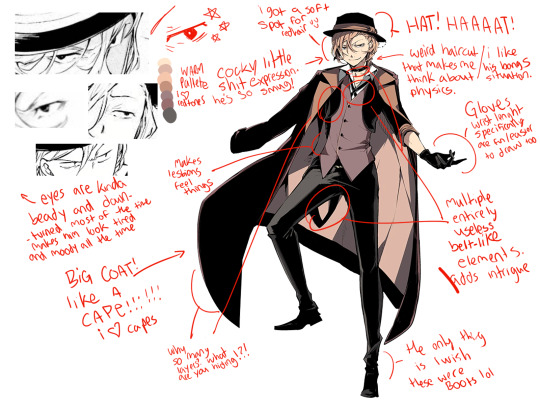
2.) his personality!
He acts so cocky, and overconfident. It's fun that he's so expressive. you'd think that a person in his occupation should maintain stoicism (which he can! he's so good at deception if 15, sb and meursault have shown us anything) but i think it's so interesting that he chooses to be more emotive with his expressions.
I think it's interesting that he chooses to be honest and try to play fair against his opponents even though it would be easier to just decimate them without talking things out, (even though that has seriously put him at a disadvantage. i'm thinking about how much easier it would have been for him if he just bust down the hospital and had his squad rush the ada in cannibalism instead of giving them a chance to negotiate). it's cool how he uses earnestness to trick people into thinking they've got an upper hand over him, like in 15-stormbringer. (on that topic though it is rough that he got matched up against ranpo in cannibalism LMAO)
I like how childish and snarky he gets with Dazai. i like how he tries to put on a totally cool put together energy infront of his colleagues (and kenji who's a fan). i like how he looks so done and ever suffering when he's with mori. i like how when he tries trying to put on a neutral face hoshikawa and harukawa draw him looking a little tired and melancholy. just a little extra on the eyebags

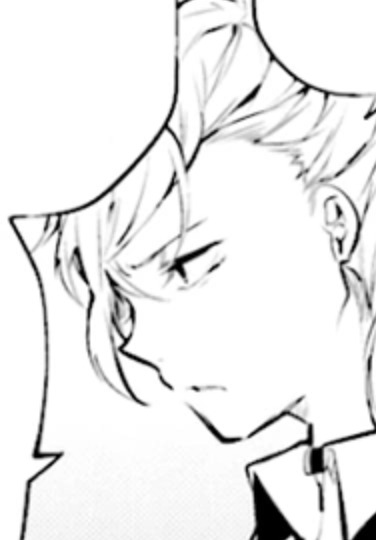
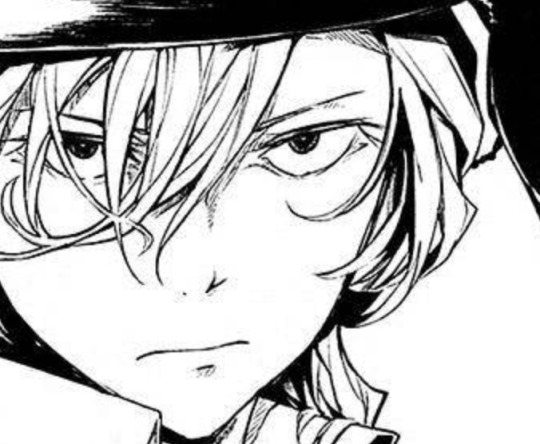
Stormbringer chuuya's probably the most compelling to me. If there's one thing that you have to understand about chuuya's character, it's that he's at his core a deeply sad person. <-His ability is called "for the tainted sorrow" after all (delightfully edgy name too btw. it's so dramatic.)
I think a lot of misconceptions about his character come from the fact that despite seeming to be relatively straightforward outwards, he's full of contradictions. If he's happy he'll play it off as aloofness, fear he'll turn to anger, when he's really angry he'll choose not to act on it, and he'll push down his sorrow and grief and make it seem like he's fine and everything is fine. Stormbringer was like an insane crash course in compartmentalization and chuuya went from being consumed by his hopelessness to 'ah guess it doesn't matter.' like damn bro, you actually doing good or are you just saying it?
bonus but i think it's really under talked about how easily he puts on masks. especially cheerful ones because he's got that too. the parallels between him and dazai are insane...

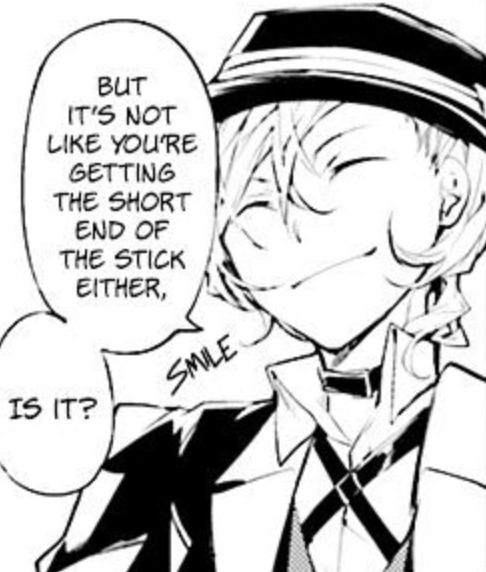
i think about the arcade confrontation scene in the fifteen manga and the tunnel fight too much.
Anyways here's some more chuuya expressions from the mangas because he's got so many good ones and ilovehim

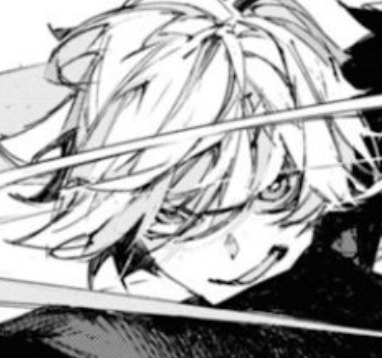
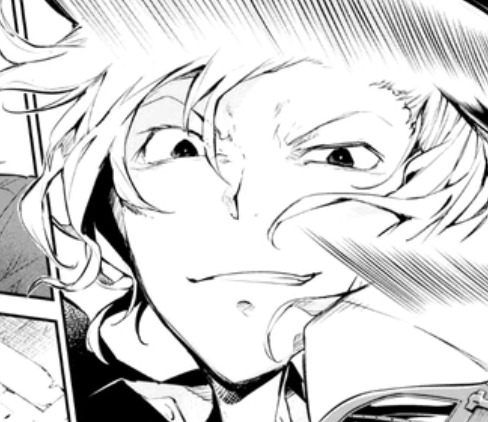



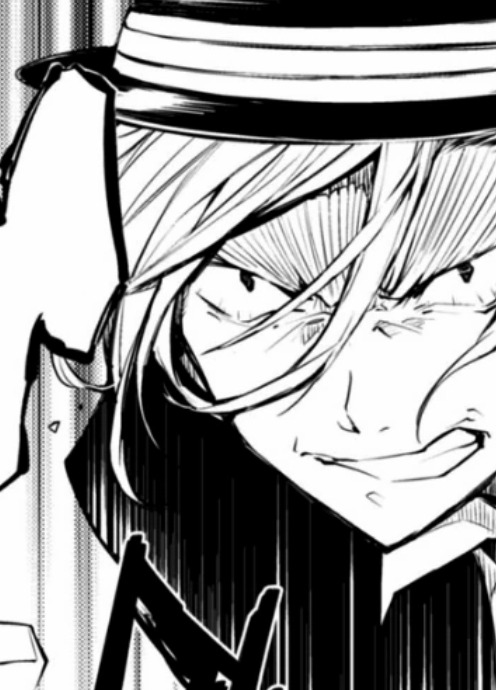
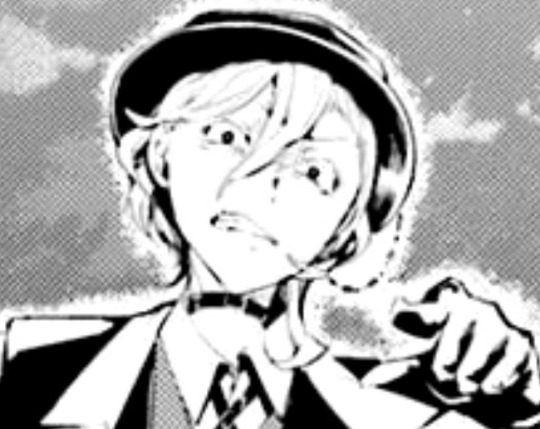
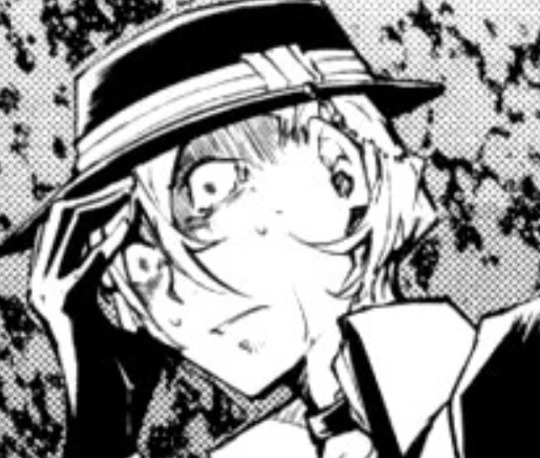
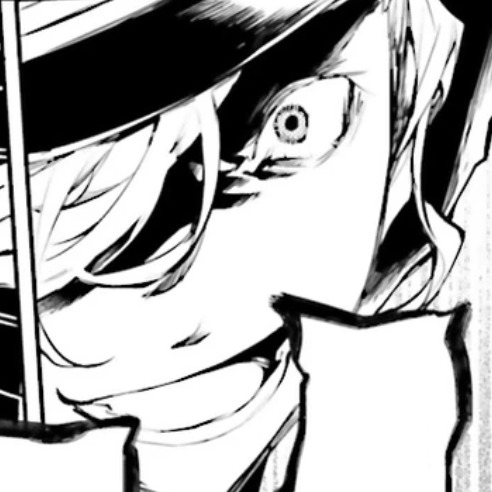
2.5) fun entrances and his not-quite-villainy
I know asagiri has totally abandoned the idea of the Port Mafia being actual villains, but as an antagonist, Chuuya is,,,,,,,, he qualifies because he's in the Port Mafia, i think.
Every time he shows up, he's usually only there to help the ada in a terribly roundabout way (usually on mori's orders). The only time he was genuinely a threat to our heroes was cannibalism . . but he seriously dropped the ball there lmao XD Even though he's a criminal and enjoys a good fight it's nice how killing people and overpowering his enemies isn't really his first option, even though that'd be so easy for him. this one exchange of him and mori is so funny for that reason too, chuuya is so alarmed

another thing i really really find fascinating is how during the Guild Arc, Atsushi got the idea of teaming up with the Port Mafia because he saw Chuuya and Black Lizard defending the streets of Yokohama. It's like Asagiri was literally waving to us and saying hey hey hey they aren't the bad guys and you should want them to succeed.
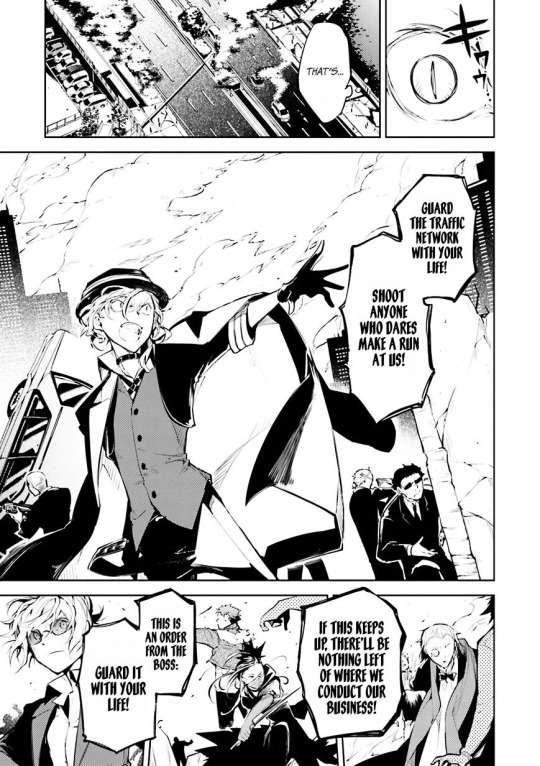
i hope chuuya and atsushi can meet. they're my favorites.
Overall i think despite him having a limited pagetime, I think it's all used very very effectively (except in cannibalism. but that's a different story). A lot of his actions ultimately aid the heroes more than anything, which is cool for a character who's apparently a key member of the enemy org.
anyways.
3.) his BACKSTORY. strap in.
context time!!!!! when i was first reading bsd (reading bc I started with the manga) i was still mainly hyperfixated on Evangelion and this is very very very relevant.
Neon Genesis Evangelion IF YOU DON'T KNOW (why are you following me if you didn't actually) is a psychological horror disguised as a scifi-mecha anime. It focuses a lot about grief and depression and messed up interpersonal relationships. but it's story is about child soldiers, government exploitation, war trauma, human experimentation etc and the likes. And so to put it REALLY SIMPLY, Chuuya's reminds me of Asuka and Rei and that's one reason why i really hooked onto him. I've joked that he could be a strayed Eva pilot but i am being genuine.
So now that THAT's out of the way. Fifteen & Stormbringer are a very very well crafted side story/prequels that gives a lot of insight to the BSD universe and really narrows in on some of the horror of this world. And I think Asagiri did a very good job with integrating this overarching lore with Chuuya's story arc, and also pacing out these releases. So.. lemme give you a play by play on how I got through this
Chuuya I think was set up from the very start to have a lot of mystery surrounding him. When we first meet him he's a cocky little shit but you're also wondering, "He's dazai's ex-partner? what did that entail? what did they go through?" And then the Lovecraft fight happens and now you're thinking "what the FUCK is corruption and WHY the fuck is corruption?" So you're casually making your way through Bungo Stray Dogs not really seeing much of him until you realize that the light novels exist so time for Fifteen!
And honestly the twist in Fifteen really DID get me too because at that point I started reading Chuuya kinda like. kinda like Naruto, lmao. The "I am Arahabaki" moment was wonderful. But there's something actually horrifying about that scene as well, the way his entire face becomes blacked out when he confesses that he's the one they've been running around looking for for the entire book. the way he completely rejects his own humanity, the way he fights with his hands in his pockets because it puts him at a disadvantage? the way he really does think he's nothing but his powers and the singularity inside him.
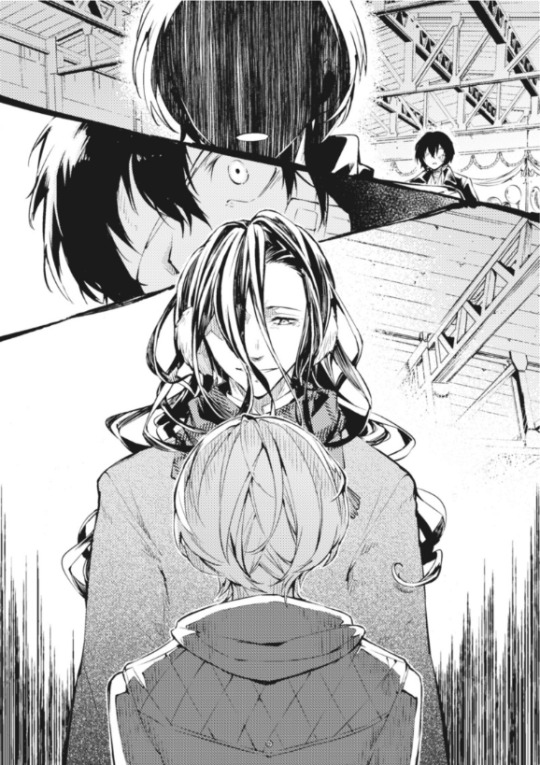
^^ something that's really really interesting is that despite being so strong, chuuya sorta sabotages himself a LOT. I do think some of that is intentional but hmmm different story but the abridged version is that even though he feels like he needs to have control over himself, I think he does want others to take that control away from him. And also Chuuya's loyalty , which is his key trait, is really rooted in who takes care of him. So he lets the Sheep take advantage of him, because they took him in, and he chooses the Port Mafia bc they gave him stability and defended him. He 'forgives' Verlaine because Verlaine wanted to do what he thought was best for him. He trust's Dazai with his life because Dazai validated his humanity. ,,
okay so anyways. nothing can begin to explain the sheer brain rot i got over Storm Bringer. Genuinely the most insane thing i've ever read in my life. Especially the lab parts with N, fundamentally altered my brain chemistry. I literally cannot think about chuuya without thinking about it. It's like, psychological horror story and a buddy cop story and a tragedy and a coming of age and the most sci-fi that bsd has ever gotten and it's so much. it's so so so much. wat?
Fifteen-Stormbringer is what REALLY got me hooked on Chuuya's character. Like he was intriguing for me until this, and I'm a weirdo who doesn't always latch onto characters based on vibes alone so i needed A Reason to like him as much as i do and i found it soooooo
4. conclusion! but not really i'm GOING to keep rambling about him in other posts lmao ;D
Chuuya might be a side character but he has SUCH a presence. I have a huge soft spot for protagonist type of characters, i'm a little basic like that but most of my favorites from a lot of fandoms are usually the main characters. And Chuuya might not be the protagonist but he is definitely the hero of another story in a way...
I think i kin him a little bit. maybe a little i can't really tell. Not self aware enough for that 🤔 you tell me.
Asagiri and Harukawa really hit the jackpot with him though
#this is an appreciation post and meta analysis fusion monstrosity#anyways I love lovelovelovleoleobloelboeooeooeoe LOVE CHUUYA NAKAHARA BUNGO STRAY DOGS#ask#bsd#yeah i took this anon as an excuse to ramble about chuuya#bite me or whatever.
239 notes
·
View notes
Text
Virtual Sketchbook 2
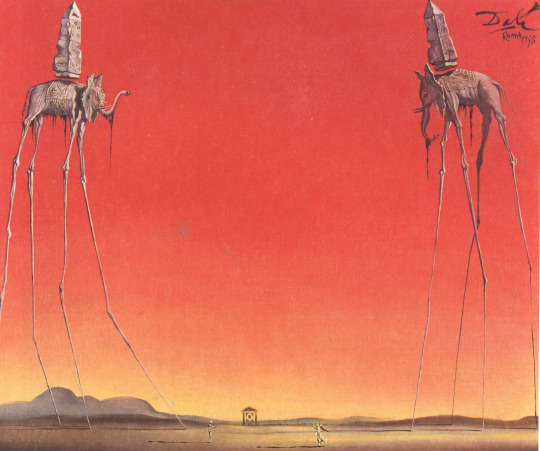
Journaling - Unity and variety, balance, emphasis and subordination, directional forces, repetition and rhythm, and scale and proportion are listed to be the most important principles of design by American artist Charles Demuth. Unity refers to a feeling of oneness from a piece, and variety refers to diversity. Balance refers to distribution, and can be achieved through symmetry or asymmetry. Emphasis refers to a focal point, while subordination refers to areas of lesser interest to emphasis further interest points. Directional forces refers to the paths that viewers follow, led by actual or implied lines. Repetition, exemplified by patterns, provides unity and continuity throw reoccurring designs. Rhythm in art refers to sequences of dominant and subordinate elements. Lastly, scale refers to size when compared with another object. Proportion is the size of parts of a whole. My example artpiece exemplifying numerous principles of design is Salvador Dali's "Elephants." There is symmetrical balance between the two elephants on the left and right side. Scale and proportion are also noticeable in the way that the elephants tower over the people on the ground, and the massive obelisks they are carrying on their back. Their extending, spindly legs make their size obvious. Directional forces also lead the eye to the elephants and the obelisks on their back. The eye automatically follows the elephant legs. And of course, the emphasis is on the elephants, and the blank background exemplifies subordination.
Writing and Looking - Mary Wallace's Peony (Chapter 1.3, Figure 1.6) shows balance through symmetry. A since of unity is present through the border and middle design. There is repetition in the repeating pattern. The stems of the middle flowers form horizontal lines. The colors are vibrant, but not obnoxious.
Connecting Art to Your World - My baby blanket that I still sleep with is a baby blue color. Coincidentally (or maybe not), that is my favorite color. Blue is the hue that dominates my closet, that I buy all my accessories in, and color I surround myself with. It is a color that brings me happiness, especially when it is in a baby blue shade. Now, if I had to choose a color scheme for my life, it would be blues and pinks, with a touch of violet. I love these colors together, even though it may seem a little childish. I like to think I am a mature and independent person in many ways, but these colors are aesthetically pleasing together, and make me happy.
Art Project - Artist's Choice -
Discussion Post - https://at.tumblr.com/nicolechen-arh2000/the-national-geographic-cover-is-my-example-of-a/f3u60zp3vdi5
0 notes
Text
Rating Every Single Name of the Wind Cover
Why? Because I can. I am not a graphic designer, just a person with opinions.
Criteria for consideration: Must be a cover in a published edition of The Name of the Wind by Patrick Rothfuss. Hardcover, paperback, and ebook are all fair game, as are foreign language editions. Some editions reuse the same cover art, in which case I only rate one cover. Some editions modify cover art from another edition. If the differences are substantial, I’ll rate both.

Kindle March 2007 Edition
Ah, the famous shirtless redhead cover. This cover is a bit infamous in the fandom for being both bad and cringey. This is not good art. It’s cheesy. The shirtless aspect is silly, and the windswept hair is so windswept, you’d think Kvothe was in a tornado. Nice balance with the title and author text, although it looks like the title and author text are slightly off center.
3/10

Hardcover April 2007 Edition
This is just a zoomed in crop of the above cover, which is a little lazy. It does make for a better cover image, except the creepy goat man bust has nothing to do with the plot of Name of the Wind. So I suppose they cancel out.
3/10

Mass Market Paperback April 2009 Edition
I despise this cover. It’s a lazy design, and the photo manipulation is terrible. Points I guess for good title text placement. But the photo manipulation is so! So! Bad! This is also the start of the trend of a hooded, cloaked figure with his back to the viewer staring out into the void. It is a bad trend.
2/10

Paperback UK June 2008 Edition
We’re still with the hooded, cloaked figure, but at least he’s facing front this time. I like the embellishment on the ‘W’ in the title text, although it gets a little pumpkin viney. Overall, it’s an ok cover. It doesn’t make me cringe, but it doesn’t grab the viewer’s interest, either.
4/10

Paperback Spanish May 2009 Edition
Same image as the previous cover, but this one is uncropped and has a different plant border. I’m not sure how successful the changes are. On the one hand, shrinking the image of the figure makes the figure look more mysterious, which is good. But on the other hand, this is a bad plant border. I thought there was some corn on the right side for a minute.
4/10

Hardcover 10th Anniversary October 2017 Edition
10th Anniversary edition got fancy, and it shows. I love the ruin influence in the title text, which is a great callback to the use of ruins in the novel and also a more creative and unexpected choice than making the title text leafy. That being said, the “of the” in the title text is very oddly formatted and doesn’t fit the style. The cover illustration is pretty great, with lots of symbolism for old fans while still maintaining visual interest for new readers who are browsing and happen to pick the book up. The Cinder statue is delightfully creepy and much more relevant to the novel than the dumb pan statue from the earlier cover.
9/10

Paperback Turkish March 2007 Edition
Another trend starting here: Cloaked figure staring out at a city in the distance. I like the painting, at least what I can see of it. I find the choice to crop out most of the painting really bizarre. Is this supposed to be a telescope we’re looking through? And the leaves look like lily pads. The title and author text leaf embellishments are quite nice here, but I don’t know why there’s a metallic color shift. Overall, a poor use of space.
4/10

Hardcover German March 2007 Edition
Oh look! A cloaked figure staring at a city. What a surprise. I rather like the title text design, which is pretty creative and a good way to make the title visually appealing. I wish the city in the painting weren’t so damn faded and distant – I think it’s a mistake to keep the visual focus on the figure exclusively and only hint at the city beyond.
6/10
Paperback Portuguese September 2009 Edition
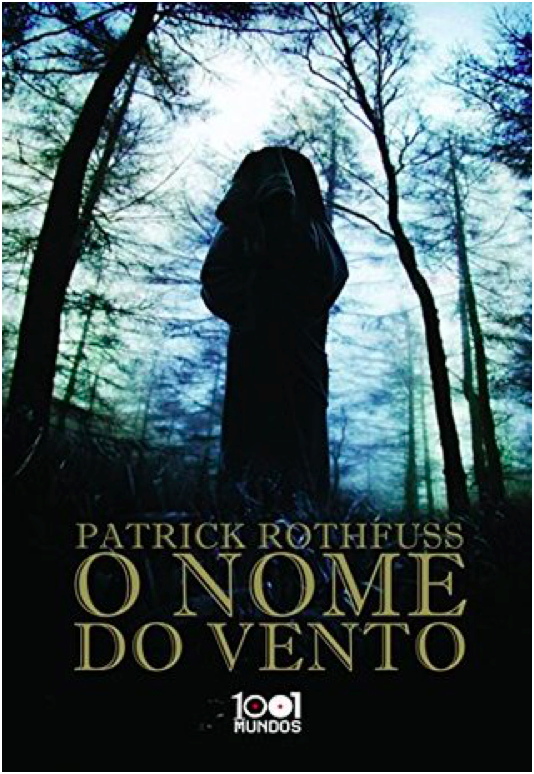
This cover is terrible. I would say the worst, but there’s more still to come. Anyways, this is incredibly bad. We’re once again with the hooded, cloaked figure with his back to the viewer, which is a lazy and uninteresting pose. The image is badly photoshopped and looks like an alternate movie poster for The Blair Witch Project. There’s nothing interesting about the image, nothing that interests the viewer. The title font isn’t boring, I guess. That’s the only good thing I have to say about this.
1/10

Paperback Portuguese July 2009 Edition
Still another cloaked figure staring off at a distant city, but this is one my favorite versions of this trope. The city is far enough in the middle distance that the figure is the main focus, but we can still see enough of the city to see that it’s cool looking. I’m glad to see the bridge from the books, which is a nice detail. The title text does a good job of filling in the empty space of the painting without crowding the other elements.
9/10

Paperback French November 2009 Edition
This is the same cover image as before, but it’s been cropped so that the figure is centered. I don’t like the change – the balance is better when the figure is off center. Also, the title text is way too big and dominates, which is unfortunate because the Spanish cover had such a lovely balance throughout.
7/10
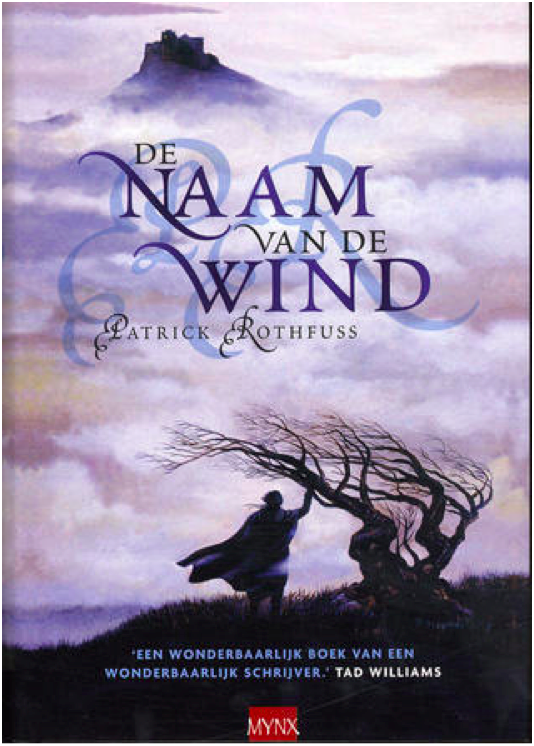
Hardcover Dutch July 2007 Edition
Yet. Another. Hooded figure. Staring. At a city. Wow. This one has a tree, at least. The image is… fine? I might be kinder to it if I hadn’t seen several better iterations of this right before. Because so much of the image is shrouded in fog, there’s very little to go on in terms of visual interest. And while I don’t mind the shadowed, muted color scheme, it also means that there’s very little to distinguish the cloaked figure and make him intriguing. The shadow initials behind the title text is horrific and obscures the title somewhat, so docking a couple of points for that.
5/10

Hardcover UK January 2017 Edition
Ahahahaha. This looks like the My Neighbor Totoro edition of Name of the Wind. It’s very silly and lighthearted, but wholly inappropriate for a book whose reading level is above first grade. If this was a kid’s book, I’d give it full marks. But Name of the Wind is very much for adults, and this cover is way too young and childish.
1/10
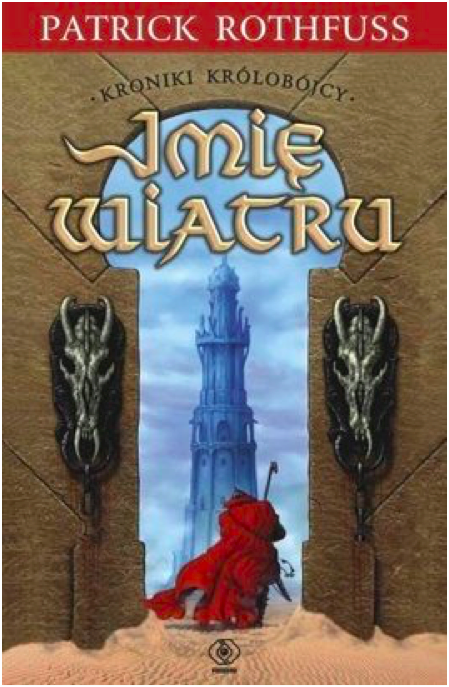
Paperback Polish August 2008
YIKES. I cannot figure out which scene or location from the book this image is trying to evoke, which makes me think the cover artist did not have the book or a text excerpt to work from. What the hell are those weird horse skulls? Why is this taking place in a desert? Why is the texture so bad? So many questions. And the effect on the title text is bad.
0/10 YES WE CAN GO LOWER THAN 1
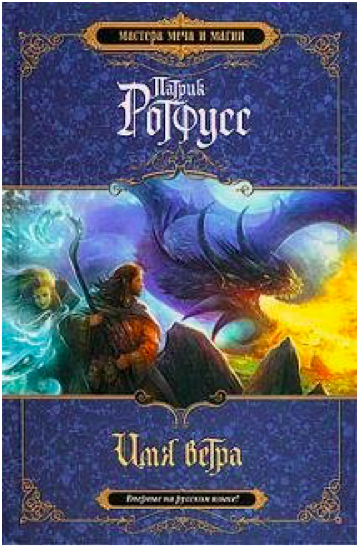
Hardcover Russian 2010 Edition
This looks like the cover to a Dungeons and Dragons manual. I suppose that’s supposed to be from the Dracchus scene with Denna, but the image doesn’t look quite right for Name of the Wind. It’s just so generic fantasy. I also don’t like how the image is cropped top and bottom to make way for a very generic marble background. Still, the image is colorful and exciting, even if it could be the cover for any fantasy novel ever.
5/10

Paperback UK 2011 Edition
What the FUCK happened here? Who let this shit happen?
-10/10
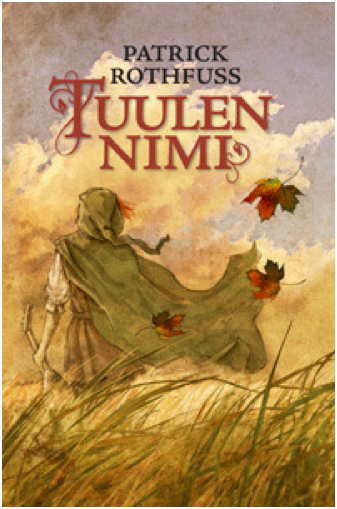
Hardcover Finnish August 2010 Edition
Ooooh, more Miyazaki fanart! This is actually quite lovely, and it fits the tone of the books much better than the kids book cover from before. I love how soft and gentle the painting is. Notice the color balance. I don’t know if this cover really ‘grabs’ you or draws interest, but it’s one of my favorites of the bunch.
10/10
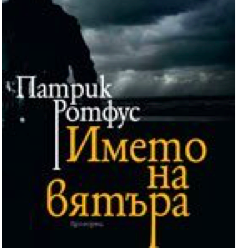
Paperback Bulgarian October 2010 Edition
I reserve the right to change my opinion later, but this may be the worst contender in the cloaked and hooded figure from behind category. I actually had to double check that this wasn’t a reused image from the mass market paperback edition, but nope! This is a brand new cover image, and it’s absolute shit. The lighting is so dark it’s impossible to make out details, the balance is way off, and the cover and title text are placed over the figure (aka the only object of interest) instead of the boring, generic storm clouds.
0/10

Hardcover Lithuanian 2011 Edition
YIKES times two. This cover art is truly awful in ways I didn’t know could still happen. Kvothe’s face looks ‘off’ because the facial proportions are all wrong. The blue mystical katana is bizarre because there’s no magical sword, much less a katana, in the story. And is that a photo of Stonehenge in the background? With yet another hooded figure?! I do like the gold foil of the title and the golden dragon embellishment, but the rest of this is such shit.
0/10

Paperback Serbian February 2011
And we’re back in the safe territory of a cloaked figure staring off at a distant city! All these covers are starting to run together, but this is a new cover art. It just looks like all the others. Once again, it’s fine. The city is a little too distant and greyed out to hold interest, and the figure is kind of generic.
5/10
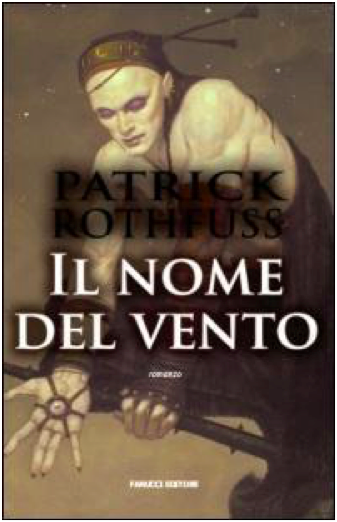
Paperback Italian 2008 Edition
I do not know what happened here. Who is this figure supposed to be? I cannot for the life of me figure out which character this is. It’s a shame, because it’s well-done art with a cool character and costume design. The title and author text obscure the image, though, and the shadow on the text is so extreme it’s hilarious.
0/10
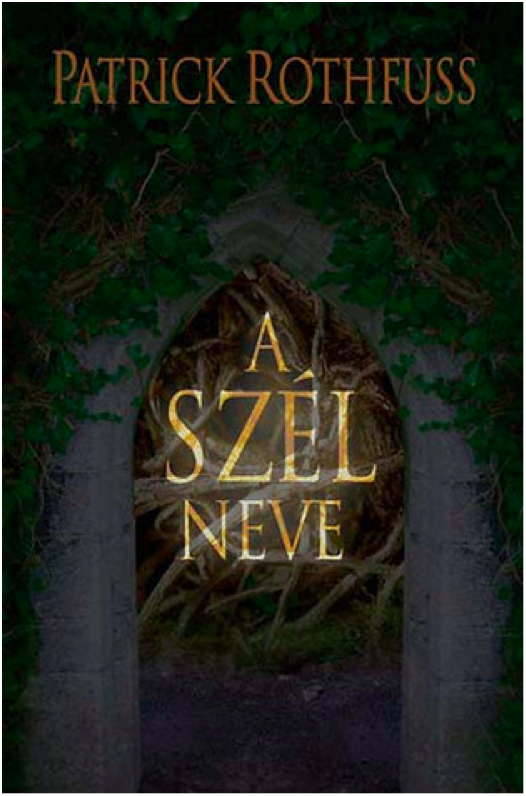
Hardcover Hungarian 2009 Edition
This is just boring. There’s no information conveyed here, nothing interesting or arresting to attract the viewer’s attention. The translucent overlay on the title is an odd choice.
2/10
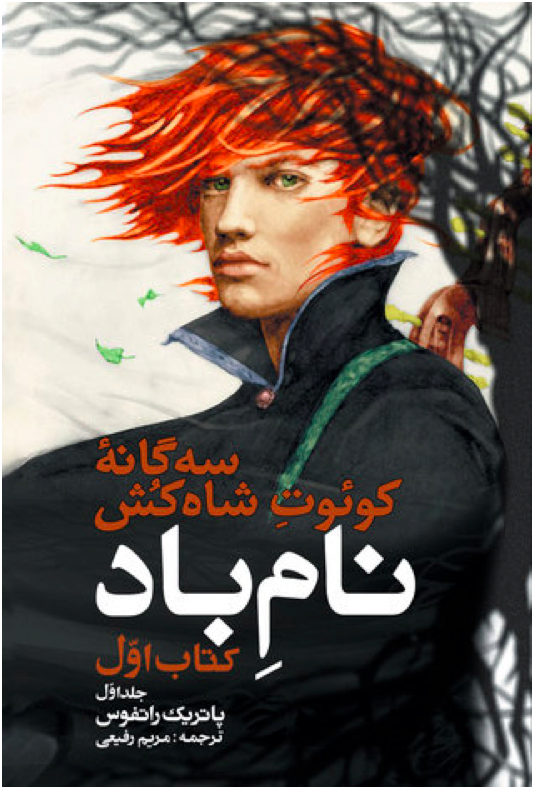
Paperback Persian 2016 Edition
I believe this was originally a fanart of Kvothe (correct me if I’m wrong please), but it’s a good one. The tree shadow in the back is distracting and obscures the handle of the lute on his back, though. I wish there was more here – it feels very spare in an unintentional way.
6/10

Hardcover Georgian 2016 Edition
Cloaked and hooded figure staring off into the distance, check. I’m not crazy about this one – the art is very soft in a blurred kind of way, and it reads as a little humdrum. The tower in the distance is quite dull – it looks like a modern office building.
4/10

Hardcover Italian October 2016 Edition
The title text is a little too high – I don’t like how it covers the figure’s chin. It’s not a bad idea to make Kvothe’s green eyes a focal point, and it’s certainly more of an original idea than most of these covers have shown. But the muted color pallete drags the whole mood down. It’s not evocative, just kind of damp.
5/10

Hardcover 10th Anniversary French November 2019
I LOVE this cover. It’s gorgeous. I love the gold foil, love the text, love the clouds. It’s stunning and timeless. Amazing.
10/10
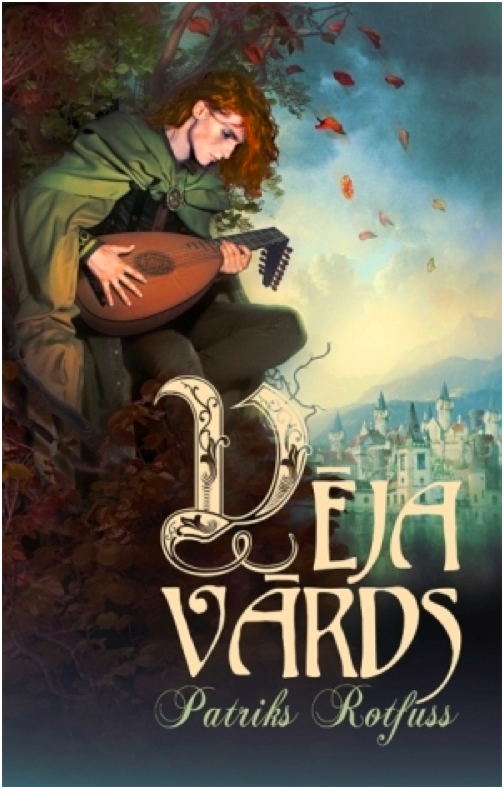
Hardcover Latvian October 2013 Edition
It’s a cloaked figure with a city in the distance, but he’s NOT looking at the city! What!! I’m rather surprised at how few covers feature Kvothe actually playing the lute – this may be the only one, actually. I don’t like the bottom fade, and I think the design is a little generic fantasy. But it’s a nice balance, and the title text is fancy and eye-catching.
7/10

Paperback Polish 2017 Edition
This cover artist also clearly wasn’t working off an excerpt from the book. The character design is so off and unlike Kvothe, except for the cloak. Wall texture looks like a photo manipulation, which is cheap. This whole thing is bad.
0/10

Hardcover Russian 2015 Edition
What is with the Stonehenge imagery? And why is that guy floating off of Stonehenge in a modern hoodie? Why is that one leaf in the top right so huge? Why is the title text red and difficult to read? At least there’s a broken lute, I guess.
1/10
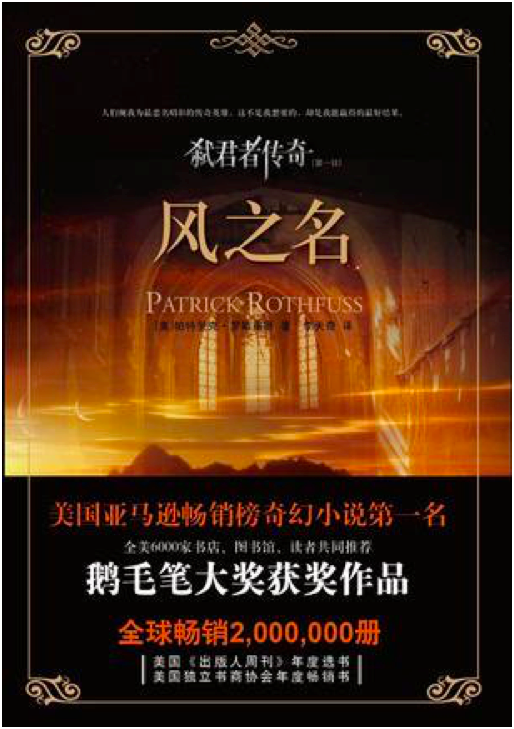
Paperback Chinese May 2012 Edition
This is incredibly lazy and the photoshop job is terrible and generic. Zero effort was put into this cover.
0/10

Hardcover Russian 2011 Edition
I’ve been pretty harsh on Russia, mostly because the Russian covers have been terrible. This is ok-ish. It’s very generic fantasy, and the castle looks like Hogwarts. But it has visual interest, even if the title text color is garish.
2/10

Japanese 2017 Edition
I quite love that they turned Kvothe into an anime character. And he’s doing stuff, too, and not just staring out into the middle distance. There’s so much imagery of the broken lute in these covers, so it’s refreshing to see the other part of this scene – when Kvothe loses his shit and finally calls the name of the wind. Fun cover, good artwork. The red title text works here because it matches Kvothe’s hair.
9/10
WORST:

BEST:
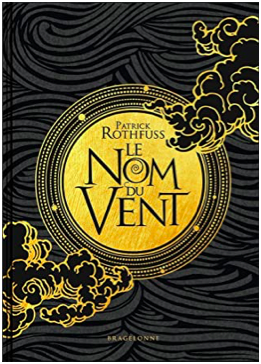
#The name of the wind#kingkiller chronicle#patrick rothfuss#book cover art#books#apologies for poor image quality i was working with what god and goodreads gave me#which was variable image quality i guess#I've been told I'm very judgemental so I decided to put those judgey skills to good use
47 notes
·
View notes
Text
Clarome
(this is an info post I published on one of my aminos some time ago. Only small grammarly adjustments have been made lol)
Real life backstory: Clarome was created around 2014 or so if I'm not mistaken, so a while ago. When I was still a child. I had gotten into warrior cats around those years and was very inspired. I however did not start it based purely on warrior cats, but a dream I had about it and a few characters from that. Based on this dream I made four different clans. I also decided leaders for them and deputies and so on, and introduced my friends to it and boy, it really became a huge part of our childhoods
In-story backstory: so Clarome was essentially a whole other dimension about an alternate earth where humans died of extinction in the stone age. This is not a realistic theory of what our world would've become if humans died out like that however. In fact, be ready to suspend your disbelief alot.
In this world, animals evolved into two different categories. Sapient and primitive. The sapient ones have two forms, anthro and feral (imagine furries) which they can change between at will. Some prefer to live their lives in the feral form completely, but this only means they'll walk on four legs and be non anthropomorphic like animals in our world. It doesn't affect their psychology at all. They are on the same intelligence level as humans and can be afflicted with the same neurological or mental disorders as humans. They're able to speak and feel and so on. These can be any animals you can ever imagine. Birds, reptiles, mammals, even giant bugs sometimes, but we'll get into that later.
The primitives however are mainly prey animals like rabbits, squirrels, some small bird species and so on. These are just like the ones in our world. And they can't become anything else. They're not given any agency of their own and are essentially prey. However where things get weird, is that a rabbit can be a sapient or a primitive. Just by looking at them you can't always tell. Sapient and primitive animals can't be in the same family and they pretty much will not breed with each other. It's treated as the same kind of taboo as sleeping with animals is in our world. It'd be like human going with a chimp.
Geography: Clarome is a large island roughly shaped like a mitten, with much tinier islands speckled around it. It's mostly varying levels of densely growing forest terrain, though it does change what kind of forests. There's also some areas with alot of cliff and hills, surrounded by forests. Most notable places being the Lightcliff and Earthquake Valley (which is a large canyon area). Both have historical significance. There are a few nice sandy/gravely beaches around but mostly it's just oops - water.
There's a few lakes in Clarome, none very large in the grand scheme of things. And multiple rivers.
-The clans-
🖤🐍Rattleclan🐍🖤
Originally founded by rattlesnakes, unsurprisingly, who gathered in a pine/spruce forest and made camp for themselves among the rocks. Snakes are one of the only species in Clarome who's anthro forms differ, they do not gain limbs of any kind. They can however stand taller and grow larger in their anthro form to better interact with the world around them. As time went on, Rattleclan gained alot of feline members who got along with the snakes due to the hissing ability and the versatile nature of cats in general. Due to this there's a Rattleclan originated species of snakecats, felines that have varying amounts of scales on their bodies, bigger fangs and snaketails. Later on various birds also joined Rattleclan, mostly predatory birds due to the fact that the non predatory ones have trouble getting along with any other species for obvious reasons.
In present day, Rattleclan population is more mixed but primarily consists of felines, reptiles, snakes and a few canines. Foxes are also very common.
•Rattleclan has a cave system at their disposal which they use as either a dungeon for intruders and codebreakers, or as a stock for various items.
•Unlike the other clans, Rattleclan has nighttime patrols
•Due to what their population consists of, during some especially cold winters part of, or the entirety of Rattleclan may go into hibernation. It usually lasts for as long as they feel it's too cold.
•Daughters/sons of the leader(s) are always referred to as Princes/Princesses of Rattleclan
•The Rattleclan emblem/symbol that represents them to the others, and in prophetic visions from Starclan, is a grinning black rattlesnake
🌧️🦎Rainclan🦎🌧️
Originally founded by waterlizards, which is a species originating from Clarome. It was founded just by a river, and so alot of it's population also consists of riverside/waterborne birds such as ducks, geese, and other Fisher birds. It too hosts alot of felines, with the few canines here and there. As well as any other reptiles and amphibians that can swim. It's mostly dominated by Waterlizards. It's part of their code that any and all members of Rainclan must be able to swim, and it's seen as a disgrace to be afraid of water or to not be able to swim. Fishing is an essential skill in this clan, even favored over dryland hunting sometimes. Sometimes. Portals are sometimes found underwater in the river.
•Rainclan has at least the second best stock of herbs due to their location.
•They're considered to own most of the territory along the river, all the way up to a small waterfall. The river eventually leads out of Clarome and into the ocean
🌳🐺Valleyclan🐺🌳
It was originally founded by canines, mostly wolves. The clan resides in a sheltered lowering in the landscape, defined as a valley. It's deep in the forest, where mostly leafed trees and bushes grow, and densely. As the wolves settled in, the area was originally populated by rabbits and hares. There were battles and discourse about the ownership of this plot of land, until the rabbits and wolves could finally peacefully unite into valleyclan. It did take a while to get used to living with your natural predator/prey though. Valleyclan is and usually has been one of the biggest clans of them all, also holding a large area of the forest for themselves. They've ran into border disputes with the others often, and have a bloody history with Rattleclan, which was fortunately settled by a needed change of leaders. Due to Valleyclans terrible line of leaders being all parent-child, it caused the other clans to make it so the leader decides their successor, and it isn't automatically signed to a blood heir or a deputy. They too, made it this way, but were the last ones to do so.
Valleyclan contains the most canines of any kind, foxes, forestborne birds, sapient prey animals like rabbits and hares, a little reptilians and even bears, deer, moose and wild horses at some point, but those have been so rare that they aren't seen much these days.
•Valleyclan has often suffered from overpopulation.
•They like to think of themselves as the center of the forest and often try to help or otherwise get involved into the goings of other clans. They tend to initiate the meetings between all the clans/their leaders
🌈💐Colorclan💐🌈
Second newest of all the clans at the moment. Originally founded by a (sparkle)cat and his wife and they just built it up from there, taking in anyone with a good spirit and unique self expression. They came in a little later into the area where the rest of the clans live in, which caused some discourse. Colorclan has the most diverse selection of animals and mixed creatures out of all the rest. It's also in their genetic code to be extremely bright and colorful and straight up wacky. They don't follow some of the same conventions as the rest and are often seen as the "Childish" and "Pathetic" clan of the bunch. They're very creative in their culture and a prominent part is the ability to make paint and fur dye. Not everyone is taught this but it's highly valued, and they use this paint to often mark territories and do general customization. Singing and songs is also a part of their culture
🥀💚Toxic-clan💚🥀
Newest of all the clans, Toxic clan was founded by a rather infamous exile, Morsoclaw and his best friend (named Knife-eye at the time). Followed thereafter by Morsoclaws wife(at the time) Skullrose who was a medic in Rattleclan, + an abandoned kitten they found and nursed back to health, + Knife-eye's girlfriend Fairytail. They later gained more numbers from various other exiles and clan members who didn't find their place elsewhere, as well as rogues. It's still the smallest of the clans, but has a very strong sense of unity, freedom and loyalty. Members can take more fluid roles than in the other clans, such as camp janitor, gatherer, full-time Queen and so on. Members are allowed to change their names themselves at any point in their lives if they so choose, without the involvement of the leader (Referred to as boss in this clan). It's also considered a horrendous act and punishable if someone names their child or warrior a name that purposely demeans or mocks them.
Toxic-clan aims to go against the rest of the clans in traditions and roles and thusly be better
#Lore#Clarome#fanclans#My ocs#My worlds#Embarrassing childhood ocs check#Not able to let go and gaining comfort from said childhood ocs check
5 notes
·
View notes
Text
continued from ( x ) ----- ( @jeanelcinegrey )
Thinking about the X-Men in the White Hot Room was so easy, especially with the running tally of alternate universes the Phoenix presented to her. Jean could see how their lives would’ve changed if Ororo appeared later, if Kitty wasn’t brought into the fold so young, if Jean was the one Charles chose as leader instead of the obvious choice, Scott. So many universes had them even worse off than this one, but that didn’t make Jean any more equipped to deal with Kitty standing in front of her now. “All the time,” Jean repeated. She would’ve said every day, but time was something of a strange concept in the Room. She’d been there for years according to Scott, but when she looked back, it felt like days. Hours. Minutes, sometimes.
Kitty laughed, even if it was more of a choked sob, and Jean managed a small smile in her direction. “I especially missed banana pancakes,” she said, deciding to double down on something so small, something that shouldn’t mean a thing at all in the grand scheme, but was so important. “You can’t really eat when you’re— you know.”
Gone. Jean remembered standing in front of Rogue, explaining that the Phoenix wasn’t just her codename, that it wasn’t even her. It was a force, a cosmic entity that Jean had no hope of controlling no matter how much it professed to love her. The rest of the X-Men seemed to be aware of that fact now. She supposed that was down to the fireworks show down on the lawn. Anyone who knew Jean – or at least, she hoped it was as easy as that – had to know that the last thing she would willingly do was put her family in danger. “It used to be … everywhere. I felt warm, all the time.” Jean swallowed thickly, crossing her arms against her chest, almost hugging herself, bracing against the new cold. “It’s gone. I don’t feel it anymore.”
For a beat, Jean flashed back to herself, the way she had justified the Phoenix’s actions so long ago. “Life comes from rebirth,” Jean said lowly. “I can … I could help you, when winter’s over. Or we could move them into a greenhouse.” Planning for the future was always the way Jean dealt with the aftermath of a fight, pretending that there was a level of stability that X-Men could never guarantee. But Kitty wasn’t a child. Not anymore, not since the day Charles brought her into the fold, really. This time, Jean really did laugh, even if it came out rough from disuse. “I’m sure Charles would have something to say about emblazoning our asses with a sparkled Gucci,” Jean joked – but the atmosphere swiftly changed, and Jean didn’t know what to do with that, even if she’d been the one to cause it.
She caught a glimpse, just a reflection, of tears in the darkness of the hallway, and her anger seeped out of her as quickly as the Phoenix’s power had when Jean got so damn tired of fighting, like a dam finally released into the lake. “Endings aren’t–” Jean took a sharp breath, trying to dispel some of the guilt that settled on her chest heavy, like a stone weighing down on her ribcage. “Endings shouldn’t be what you want. Endings are the worst part.”
They were never going to have that final fight that ended things. They were never going to be able to rest. The only peace Jean ever got was in snatches of moments. Pancakes with Kitty. Watching TV with Bobby, laughing as he imitated the accents on the screen. Looking out over the lawn to see Scott training the new students. But was Kitty wrong for not seeing the world as Jean did?
Never.
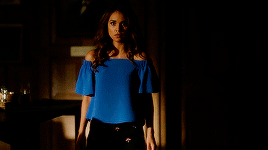
“You’re not wrong,” Jean said, lowly. So far as her sense of reality, the bleakness of it … maybe she was cynical now. Maybe she was jaded. But that’s what three attempts at death would do to you, and it’s what being dragged into something you didn’t expect would do to you, and it’s what fighting a war since you were a teenager would do to you.
Kitty knew that more than most.
Jean looked up from her feet at Kitty’s next words, and she didn’t hesitate before crossing the distance between them, wrapping her arms tightly around the younger girl. “I thought about this all the time too,” she whispered. “I missed you a whole lot, Kit Kat.”
All the time. The admittance had soothed an invisible ache; selfish comfort, to know Jean had thought of her just as much as Kitty had. She couldn’t say what the afterlife must have been like, knowing Jean could even think was a shock enough, but the after life of living without Jean was its own thing. Some times the shadows made by the plants looked a little like Jean, which was ridiculous, because Jean looked nothing like a fern. But her mind saw what it wanted to see, and all it wanted to see was Jean. “All the time,” she repeated back. Now Jean was here and her mind wouldn’t have to pretend the pointy ends of their Chinese Evergreen looked anything like the older mutant’s hair. “I did too.”
Kitty’s heart skipped a beat; surprise, laughter and amusement all choking their way up her ragged body. “Banana pancak---” she stopped herself to laugh, this time without the undercut of a sob. “You would miss the type of pancake with the lamest fruit on it.” Not chocolate chip, caramel, cherry or blueberry---but banana. Though with some fresh maple syrup from up north, Kitty could see the appeal. She’d have to ask Logan to bring them some, if he ever found himself across the border sometime soon. “I never asked what the afterlife was like...I guess there’s no buffet, is there?” She paused, “there’s bananas and flour in the kitchen.” It was also three in the morning and hardly the time to imply they might enjoy some pancakes, but it was less about trying to fill a hunger she didn’t feel and more about trying to give Jean back all she had given. “We could...” she trailed off, “there’s bananas in the kitchen.” And repeated herself like a parrot that couldn’t figure out how to communicate right with the humans.
“So do you feel cold now?” Kitty did the math in her head, it must have been something like thirteen years since Jean first bonded with the phoenix. Did Jean remember at all what the days felt like before the fire? Was she cold then too? Or did things with the Phoenix color everything else; did that kind of power make you forget? Kitty swallowed back the questions, fear bubbled up at the idea of being answered. If she knew just how much hurt sat behind Jean’s chest, then Kitty in turn would ache knowing just how little she could do to ease any of it. She didn’t think the coldness Jean might be feeling would be solved by warm blankets and woolly socks. In the end, what can she do but stand there, praying by a god she did not believe in that Jean would know happiness like she deserved. ( Could she wrench her own heart from her chest and offer it out, she might have. Some days she felt strong enough to do so, most days she was too afraid to reach inside and lose the thing she took for granted ) “I’m sorry,” she blurted suddenly, gripping on to unspoken words. ( It should have been convenient with a telepath, if only Jean would intrude just a little so Kitty wouldn’t have to explain herself. )
“Life comes from a lot of things,” Kitty answered a comment she knew wasn’t for her, “it doesn’t need to be death or fire.” The young mutant shook her head, then paused, and nodded. Her instinct was to refuse, she couldn’t remember the last time she let someone help her with anything. But building a garden with Jean sounded nice; sounded like something she’d like help with. “Mhm, no not the greenhouse.” She liked the idea of holding Jean to some sort of detached promise. Perhaps she wouldn’t get no more dying but she’d get the promise of an after winter and it would have to do. When their garden was done, and spring brought them blooms, Kitty would push and ask for apple trees to be planted---and she’d wait on the promise that they’d pluck the first apples, bitter and small as they probably would be, and bake them into an inevitably terrible pie. That would be the promise of another winter, and then another year, and another two after that. And if their tree didn’t work they’d have to plant more, one after the other, year after year. Like that, life would be trees: taking root, growing tall and strong and impossibly old. Kitty would ask for a million years with Jean if she could, a million years with all of them.
But a million years was childish plea, and so Kitty only asked for an after winter and a garden. “A nicer garden outside seems better. Better than the hedges we’ve got, anyway.” She smiled, “Charles doesn’t know fashion. We should get him a bedazzled shirt, then he’d know what fashion is.” Not that Kitty had much of a clue what fashion was anymore, the part of her that’d been passionate about that died when...well, when Jean did, the second time, and she’d learned being a kid wasn’t something the world was going to let her do. Be an adult; dress boring; wear a uniform, not a costume. “Come to think of it, none of our outfits look good. Why do the Avengers get to look hot while we look like off-brand safety-vest models? This is why people hate mutants, we lack sex appeal.”
Her humor layered with the goal of distraction withered away moments later; she’d been the one who started yelling at Jean, she should have expected that no amount of joke would cover it up. But she didn’t want to be mad anymore, even if she still was impossibly so. She could scream and kick all she wanted, she knew Jean would still sacrifice herself the next moment she had to. There would always be things Kitty couldn’t change, no matter how much she wanted. “I wanna be able to go to your wedding, Jean. Or your fiftieth birthday party. I wanna be there when you win a noble peace prize, and I want you to be there. You’d think a doctor would have a little more hope, wouldn’t you?”

Self-sacrifice was a funny thing---and yet, the very thing that kept tearing Kitty from her friends. She wished with all her heart, with all the force her body could manage in Jean’s arms, that she would stay. That the next time the world needed to be saved, she would turn away and it would be okay. In her tears she prayed, in the ragged exhales she used to steady her thumping breath she begged, all she’d wanted in that moment was for Jean to live; to stay warm and happy and free. “C-careful, Scott’ll get jealous if you say stuff like that,” she murmured against the fabric of Jean’s shirt, bubbly laughter caught between swallowed sobs. “I missed you so much, Earl.” She pulled back before she was sure she’d end up soaking Jean with the strange waterfall that manifested in her eyes at some point between trying to be mad and then failing miserably at it. “Like the tea? Earl Grey?” she sniffled, “I had all this time to think of a funny name for you and that’s all I got.” One day, she’d think of one. Jean might not have been able to promise anything, but Kitty did it anyway---Jean would stay. Next time the world demanded sacrifice, it wouldn’t be Jean, Kitty wouldn’t let her. Not this time. Not ever again. “Jean-a colada...no that’s dumb.”
If she had to bury Jean again, she’d personally come into whatever the heck the afterlife was and slap her.
#hhahaa....dont ask me why this is so long#pretend it's a reasonable 500 words#jean 001#jeanelcinegrey
3 notes
·
View notes
Text
Brief 1 - UFlix
The Beginning
We were asked to develop a concept for a brand, product, service, event for a clearly defined target audience. we had the option to choose any target audience we wanted, due to that I decided to choose something that I was passionate about, films. I have always been interested in films, I love the whole idea of being immersed in a whole other universe, it is the perfect example of how strong humans imagination is.
I started researching about the film industry to see what type of apps and website there were already, how they were used and by what target audience they attracted. What I started noticing is that there weren’t any websites in which users could watch a movie and at the same time review it. It was such a simple idea, since we as humans try to create the easiest route to do anything, we want everything to be there at the tips of our fingers.
I feel like the concept that I have created opens the door of opportunity to users that Netflix might have not yet considered, the type of customer that I am interested in reaching is somewhat an extension to Netflix customers today, however, they will be customers that would be more interested in the making of the film, for an example, the cinematography and framing of the shots.
Brief
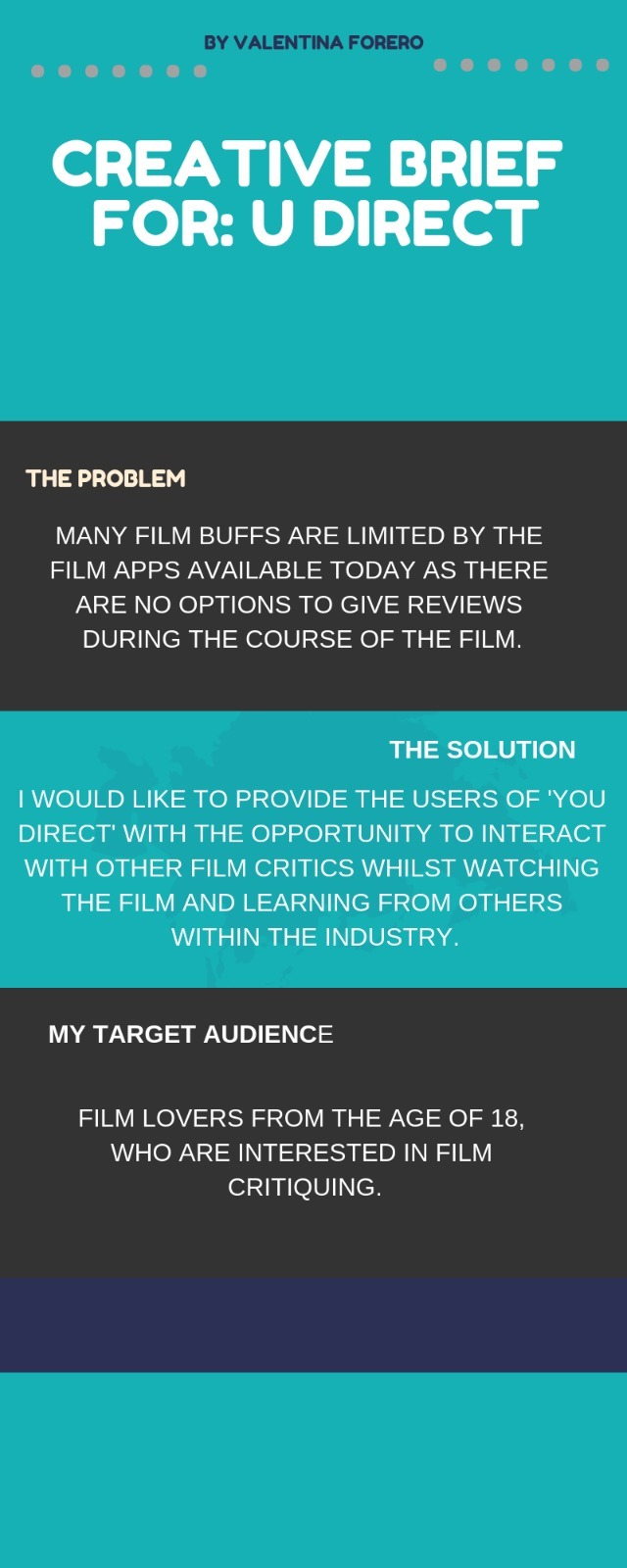
I started off my project with focusing on the brief since it was the first time I ever made a brief I thought the best option for me was to look at other briefs to learn the structure in which it should be made in. Since Scribershive project was given at the same time as this project I simply looked at the structure of that specific brief to identified the key concepts to include for my Brief 1.
With a brief you must have these key concepts:
- Problem: identifying the issue in which your concept was influenced by
- Solution: how you would be able to fix that issue with your idea
- Target Audience: defining my target audience by market research
By having these key concepts it gave me a clear understanding of how to plan and create my project, along with giving the viewer a clear understanding of my product.
Research
With the research, I wanted to see how other apps and websites had structured their content. What I noticed they had:
- profile page
- review page
- news page
- rating system
- activity page
- watched list

- Flixster Video App


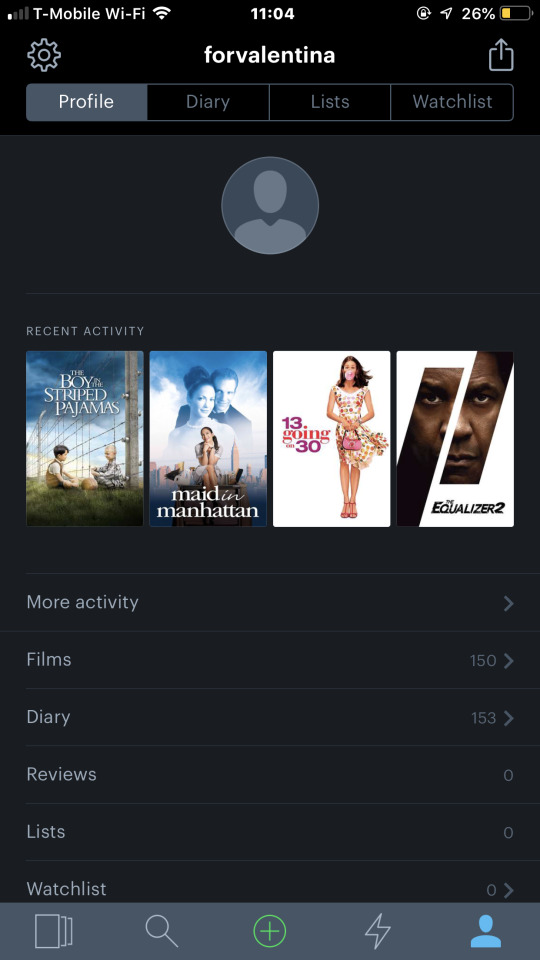
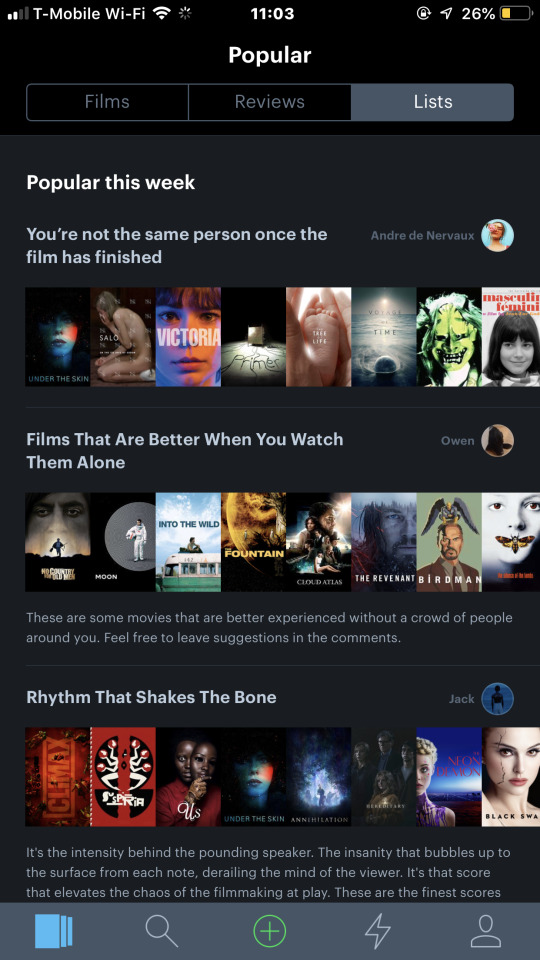
- Letterbox App

- IMD.d App

- Netflix App
All these apps gave me key ideas in which I should have for my website, however, none of them had the feature of being able to critique a film while simultaneously watching it. In addition, none of the apps I research had a social media feature which I believe is a key concept which this market is missing.
Target Audience
Since I decided to create my website for film critics and ‘film industry lovers’, I have always included myself as the type of target audience in which my website should be aiming for. Due to that, I was able to identify the key concepts and features that were missing on the pre-existing film apps and create a website in which I was able to include the additional features I as a target audience would want.
In addition of being a target audience, I wanted to do a target audience questionnaire my close friend Basim Kadhim to get a better understanding of what is missing in pre-existing film apps to have a clearer vision of what I should include on my website.
Basim Kadhim:
- Studies BA The Art of Visual Effects at Escape Studios (High Holborn, London)
- 22 years old
- Cinephile
Target Audience Questionnaire:

Basim Kadhim Social Media :
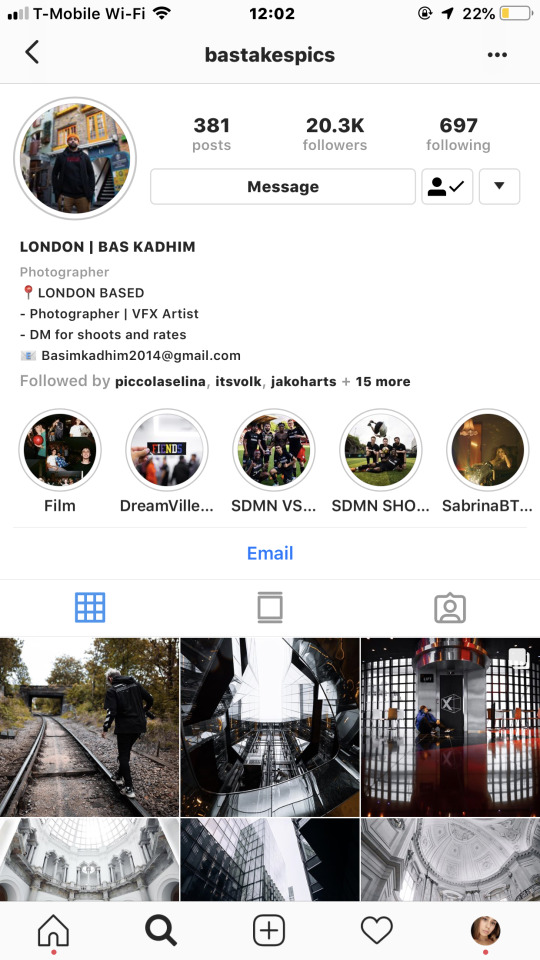
What will my website do
- Provide the ability to critique a film while simultaneously watching it
- Allow users to communicate with other users to create a sense of community
- Create a platform for cinephiles to be able to connect with their favorite icons in the film industry
- Allow users to create lists (just like playlists) of films to recommend other users
- To saved star scenes of films onto a ‘watchlist’ to view in the future
- Repost other user’s critiques onto their profile
- See a live feed of what the user’s followers are watching or have watched (Friend Activity)
- ‘Popular This Week’ section
- Trend section with film news with the user would be interested in
Logo Design
While deciding how I wanted my website to function, I was noticing that for my website to function exactly how I envisioned it I needed an existing platform which users are already using to watch films. Due to my own experience, I choose Netflix, since it’s already an internationally well-known platform.
Deciding a name, font logo, and color scheme
Since I decided that my website should be a branch of Netflix to be able to use their film rights. I wanted Netflix users to recognize my website logo which is why I decided to create my website font using Graphique.
Staying along with the whole idea of being a branch of Netflix, I wanted a color scheme which complemented Netflix’s color scheme. Which is why I decided to go for a light turquoise (color code: #16b1b5) to be the main color since when it comes to complementary colors, red is complemented by blue and I wanted to use white ( color code: #ffffff) as a fill-in color since white represents beauty and minimalism.
When it came down to the name I was simply brainstorming several words such as Netflix, film, screening, watching, theater, movies, youtube, and cine.
Prototype Names:
- YouCine
-FlixThru
-YouPic
-UView
Final Name: UFlix
Old Netflix Logo:

New/Recent Logo:


Final Logo Layout:

Subtitles Logo Layouts:

Final Icon Layouts:

Learning Adobe XD and Photoshop
When it came to creating my website I researched different programs to see which one was best to design on. I came to the decision to use Adobe XD since I noticed it was a practical program to design since it had several similarities to Photoshop. I started by looking up tutorials on how XD works and even read up on some short cuts so I could get familiar with the program. Once I learned the basics of XD I was able to start on the basic layouts of my website and even proceed to create the details within the pages.
This project was an opportunity for me to learn photoshop again, I always knew the basics of Photoshop but I found myself some moments during this project stuck on some aspects of photoshop. I retaught myself with Youtube tutorials and can now say I am 100% comfortable working with Adobe XD along Photoshop.


Website Design Development
Home Page:

With the home page, I was influenced by several different social media layouts.
Twitter: The whole scrolling through a home page is a major concept that I wanted for my home page. I thought it was the clearest way for the user to view their follower’s reposts, along with being about to repost and comment.

Spotify: The idea of ‘Friend Activity’ was created when one day I was listening to my Spotify on my laptop and it gave me the ability to see what were the lastest song which my friends were listening to. Since the whole concept of social media is to communicate to the world, everyone wants to see what everyone else is doing. Which is why I believe is concept is one of the strongest features on my home page.
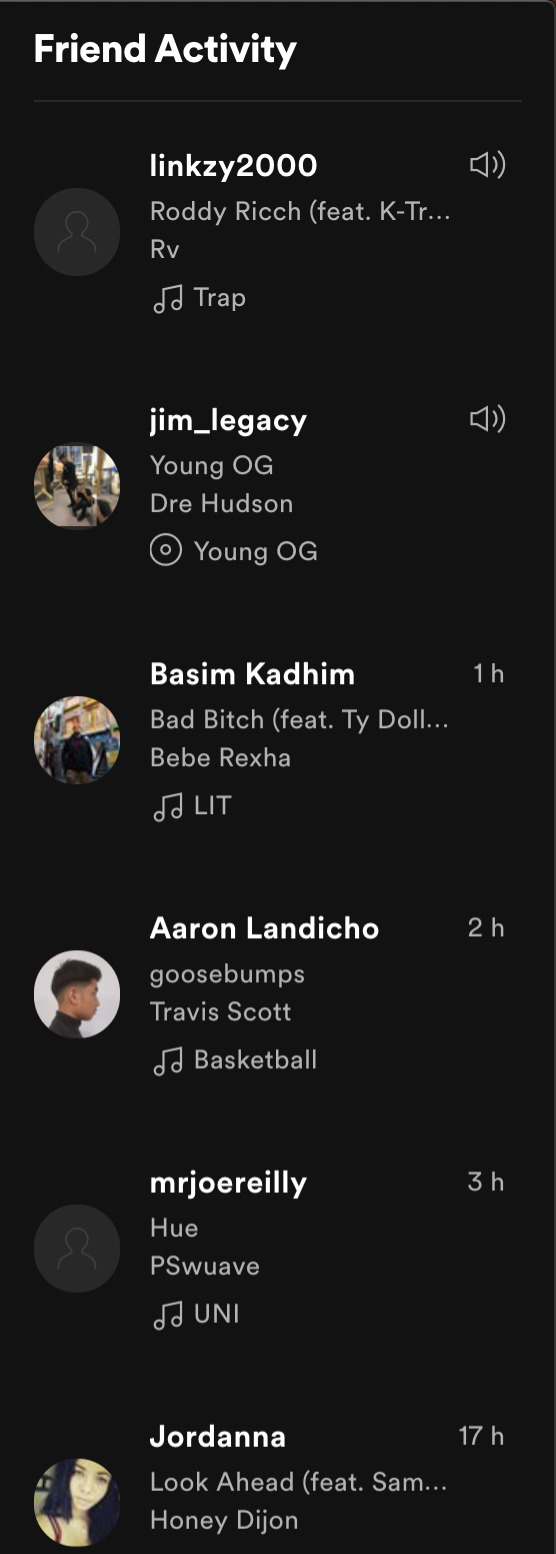
Letterbox: The ‘Popular This Week’ feature was inspired when I was on my letterbox app and saw the ‘popular films’ section. This is such a convenient feature for the user when they need some suggestions. This feature can also be found on Netflix at ‘Popular on Netflix’ section.
By finding the pros and cons during my research I was able to create an interactive home page which has the best and missing features from popular social medias, to be the ideal website to go to.
For You Page:



The For You page was design based on the ‘For You’ page on Twitter in which you can find several twitter hashtag trends which the app knows that you would be interested in following from what you have liked and reposted. I wanted to have the same feature on my website since I believe it’s the best part on Twitter because you get to be updated on news that customized for the user.
Profile Page:
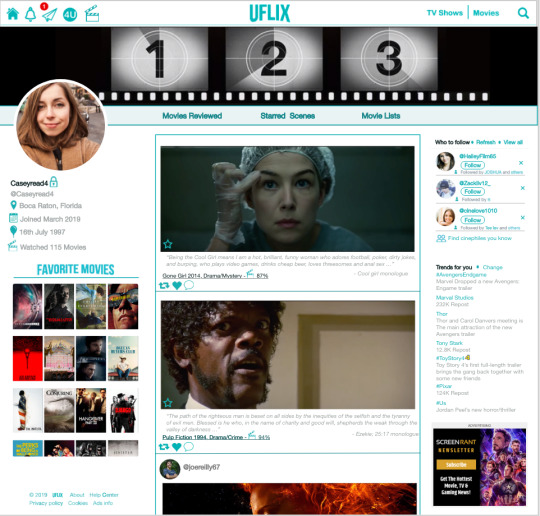

I was heavily influenced by Twitter when it came to the profile page, what I noticed was the several social media profile pages have the same layouts. I believed that the Twitter website profile page layout was the best design for UFlix, it keeps the same scrolling design from the home page which still makes it simple and easy to read for the user. Along with having a ‘Favorite Moves’ and ‘Trends for You’ section for the users to get to know other users interests.
Screening Page:
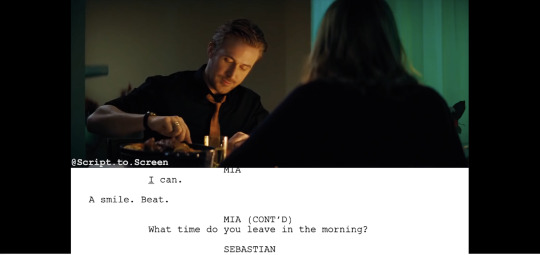
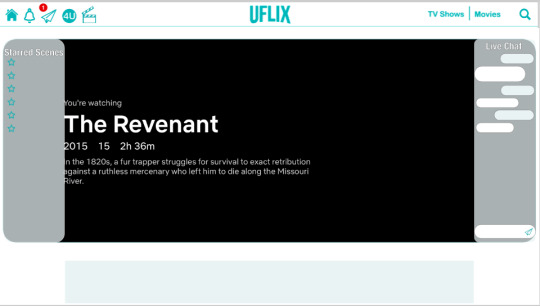
With the screening page, I was influenced by this Youtube channel called, Script to Screen. Which is a channel that shows you scenes from a movie while showing the script right under it. From there I got the idea of why not change the script to a messaging/writing platform so the viewer can chat or critique at the same time. It was a simple idea which I couldn’t believe didn’t exist yet.
Login Page:
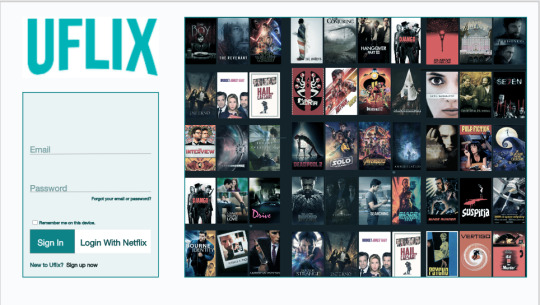


On the idea of the login page, I didn’t go too far on the design concept since I wanted my login page to be part of Netflix. I took the design and created the login page with UFlix’ s color scheme (color code: #16b1b5).
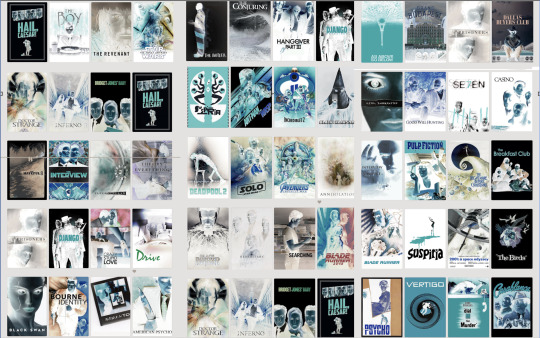
This was a prototype version of the side image on the login page. I was not satisfied with how it was difficult it was to read the titles of the films.

I wanted to add a bit of me within my designing of UFlix, which is why I created this collage of movies to be a side image on the login page. All the movies that are in the college are movies which I have already seen.
Improvements




Halfway through designing my webpages I started looking through the slides and noticed that the bold border around the sections on the website made UFlix unprofessional, almost childish. Which is why I redesigned it without the border to give it a clear look.
Final Outcome
Login Page
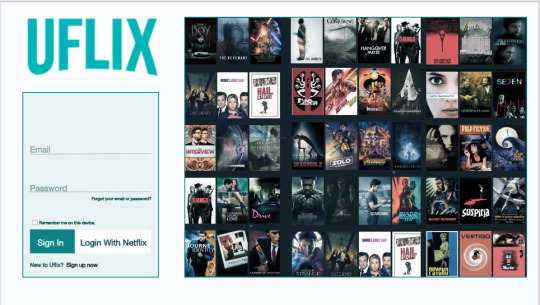
Home Page

Screening Page
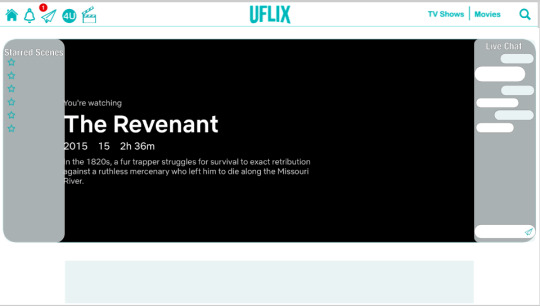
For You Page

Profile Page

Preparing for Exhibition
For the preparation of the exhibition on the 20th of March, I decided that the best way for me to present my project was to use the XD feature using the wireframing that I created to project how the website would work by clicking through.
I also printed out slides of my website so the audience can have a clearer view of pages.
Conclusion
Ove all this project has given me a clearer understanding of identifying the target audience. Especially since this was an independent project I found myself having a better understanding of this course and of my future career.
2 notes
·
View notes
Text
10 Tips: Make Your Business PowerPoint Templates More Effective
The design of your Business PowerPoint templates is frequently overlooked. Everyone knows that a picture is worth a thousand words, but it appears to be exactly the opposite in PowerPoint-land.
A thousand words are worth a thousand pictures; that seems a more appropriate phrase. The presenter reads aloud from slides that are completely packed with text. This is why PowerPoint has a dusty and static appearance. A squandered chance!
An excellent Business PowerPoint template may help you communicate your message to the audience. That is why we have compiled a list of 10 PowerPoint design recommendations to assist you in steering your presentation on the proper path.
1. Keep it short and to the point
One of the essential things to remember is that business PowerPoint templates are only a tool to help you tell your message. Avoid displaying actual text on the screen. Instead, strive to keep your bullets brief and to the point.
This draws your audience's attention away from the slides on the screen and toward you.
2. Select the appropriate font
Choose a traditional typeface rather than a new one. Choosing the incorrect font might easily render your work illegible to your readers. Calibri and Helvetica are all solid options. These typefaces are accessible on all platforms presentation pro.
3. Does Size Matter?
Choosing the appropriate font size might be hard. On the one hand, anything you put on the screen must be readable by your audience. However, you don't want your text to take too much space on your slide.
The minimum for headers is roughly 20pt, whereas the minimum for the body is 18pt. Using these sizes, you may be confident that your text will be legible in any scenario. This includes laptops, PCs, tablets, etc.
4. Contrast
Besides the look and size of the font, contrast is essential. If you use text on a photo, make sure the type is legible by adding a border or putting a shadow around it.
5. Relevance and quality are key
Typically, your writing is accompanied by a low-quality picture. When people talk about cars, the first image on Google Images is chosen.
Your presentation will appear unprofessional or childish because some visuals are sketches and doodles. Make sure to choose high-quality photos that complement your messaging.
6. Are screenshots or diagrams better?
Screenshots, schemes, and diagrams are rarely useful in presentations. They create dull slides with too much information and detail, even though the content is generally critical to your tale.
Combining the diagram, scheme, or screenshot with a picture is a simple remedy for these slides. These may simply be mixed with an iPad, laptop, beamer, or PC image.
7. Visualize these as much as possible!
Graphs may provide you with the results you want. Business PowerPoint templates have a plethora of 'donut-graphs' that are great for establishing comparisons.
Choose the donut graph that displays your percentages in the center of the graph. In this manner, your audience understands what you're saying right away.
8. Make your tables as simple as possible
Tables are often loaded with data and statistics. As a result, the slide appears packed a disorganized. Remove any extraneous outlines, colors, or borders. 'Keep things simple' and 'less is more' are important concepts to remember while creating tables.
9. Cut down on the number of transitions
After producing one, people frequently decide that a PowerPoint presentation is dull or motionless. They begin to use transitions at this time. Different transitions are then employed to 'bring the presentation to life.
This, however, is not the way to go. Business PowerPoint templates have the most varied transitions, sometimes perceived as annoying and juvenile. A basic 'fade' effect of transitioning from slide to slide is sufficient. Again, the adage "less is more" applies.
10. Use only basic colors
Colors are frequently used to add 'flair' to slides. It is critical to determine your audience and the goal of the presentation before selecting colors. Choose attractive colors.
Reference
#download professional PowerPoint templates#powerpoint templates#business powerpoint templates#ppt templates#free powerpoint templates#powerpoint backgrounds
0 notes
Text
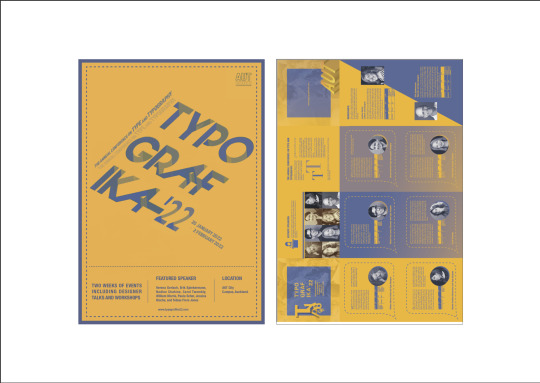
First concept
Things need to be changed
- Poster side
1.the color scheme: not trendy, not much differences in brightness between two chosen color
2.border style: dotted outline creates the chidish mood, too close with main typography illustration
- brochure side
1.color
2.Front page: the photography of students in conference layerd on the front page looks hard to reconize and some inconsistencies in size of fonts, Lack coherence with the poster side
3.Back page: 3D font looks bit awkward, the photograpgh is better to take it off
4. pages of speakers: dotted borders looks a bit too childish(not sutable style with the contents as it is serious event), size of fonts in table are not readable

Development process
0 notes
Text
New Post has been published on Cinephiled
New Post has been published on http://www.cinephiled.com/interview-creative-team-behind-taika-waititis-brilliant-jojo-rabbit/
Interview: The Creative Team Behind Taika Waititi’s Brilliant ‘Jojo Rabbit’
Writer/director Taika Waititi (Thor: Ragnarok, Hunt for the Wilderpeople) brings his signature style of humor and pathos to his latest film, Jojo Rabbit, a World War II satire that follows a lonely German boy (Roman Griffin Davis as Jojo) whose world view is turned upside down when he discovers his single mother, Rosie (Scarlett Johansson), is hiding a young Jewish girl named Elsa (Thomasin McKenzie) in their attic. Aided only by his idiotic imaginary friend, Adolf Hitler (Taika Waititi), Jojo is forced to confront his blind nationalism. The film offers a funny yet profoundly moving child’s-eye view of a society gone mad with intolerance. Drawing on his own Jewish heritage and his experiences growing up surrounded by prejudice, New Zealand filmmaker Waititi (whose mother is Jewish and father is Māori) makes a powerful statement against hate with this pitch-black satire of the Nazi culture that gripped the German psyche at the height of World War II.
I admit I am not a big fan of films like Life Is Beautiful that have attempted to bring fantasy or whimsy to stories of World War II, so I was nervous going into this film, and yet I loved every second of it. I thought that Waititi and his team achieved the perfect balance between the fantasy elements of the film and the stark reality of the situation. As one critic said, “It shouldn’t work…but it does!” Based on the book Caging Skies by Christine Leunens, Jojo Rabbit, winner of the People’s Choice Award at this year’s Toronto International Film Festival, also stars Sam Rockwell, Stephen Merchant, Alfie Allen, and Rebel Wilson. I sat down with several of the incredibly talented people who helped create the unique look of the film: production designer Ra Vincent, Visual Effects Supervisor Jason Chen, Makeup and Hair Designer Dannelle Satherley, and film editor Tom Eagles.
Danny Miller: The details in the sets were just stunning. Did you recreate this German village from scratch or did you find real settings that you could adapt for the story?
Ra Vincent: We had done so much research about this time period and did our breakdowns of what we needed, but it wasn’t until we found our locations in the Czech Republic that this world we were creating really expanded. The borders during the Nazi occupation were constantly shifting and the Baroque village we found in the Czech Republic had become a German territory during the war. We even found out that there had been Nazi rallies in some of our locations. It was exactly the aesthetic we needed.
Given the history in that part of the world, was it a bit dicey to bring in all of the swastika flags and banners that you needed for the story?
Ra Vincent: Yes, it was. We had some early discussion about swastikas with the studio, they were very nervous about it, but in the end we decided to do what we wanted. We felt we needed the swastikas or the story and the satire would not work at all. The idea was to confront hate and how that regime was formed. We could not remove the importance of that insignia.
Jason Chen: The swastikas had so much weight in that town. I remember when we were shooting in the building that we were using as Gestapo headquarters and had to put up swastika banners. We actually had several local crew members who told us they couldn’t go in there because their family members had been tortured or killed by the Nazis. The weight our locations carried was a good reminder to us about the message we were trying to convey.
Dannelle, speaking of historical sensitivity, you will now always be able to say that you did Hitler’s hair and makeup. What was that like?
Dannelle Satherley: (Laughs.) Well, with Taika’s character, he was an imaginary version of Hitler as seen through Jojo’s eyes, so we were going for something more roughly hewn than you might see elsewhere. Sure, we had to have the touchstones that everyone knows like the moustache and the combover, but he was never intended to be a carbon copy.
Were there times when Taika was directing in full Hitler drag?
Dannelle Satherley: Oh yes, many times! It was definitely something to see.
I’m sure the on-set jokes were writing themselves: “Help! Our director is Hitler!” Tom, I imagine for a film with such serious themes with comedic elements, finding the exact rhythm in the editing was everything. How difficult it was to maintain that balance?
Tom Eagles: It helped that Taika’s script was amazing. There were differences in the details but we were faithful to the feeling of the script, trying to walk that tightrope between black humor and real emotion throughout.
Were there a lot of clues in the script about how everything should look?
Ra Vincent: Absolutely. Taika’s writing is so good and there were many clues about the characters in the script that you could pull from about what type of environment they would be inhabiting. For production design, it pays not to overstate things, you don’t want to detract from the performance. But, for example, knowing how artistic Rosie (Johansson) was, we added all sorts of nuances in the decoration of the house which also played into Jojo’s view of the world through somewhat rose-colored glasses.
I want to see the film again just to more closely examine all of the delicious details of that house!
I was working with a wonderful set decorator, Nora Sopková, who has been working in Prague for a very long time and she knew where to find all the best things. I like to provide as much realism for the actors as possible. If you’re going to put food on the table in front of them you make it really nice to eat, you fill the drawers with clothes of the period in case they open one during a scene, you add all these authentic touches so there’s an opportunity for bits of spontaneous characterization.
I know in many of Taika’s projects there’s a lot of improv. Was that a worry when trying to maintain the right tone in this story?
Tom Eagles: There were very different types of scenes in this film. For a dramatic scene between Scarlett and Thomasin, for example, they would run through it normally, get some direction, and then perhaps try a few new things when they did it again, but it was a very traditional process. They were amazing actors working with an amazing script. But with our comedians it was something else entirely. They’d constantly be stopping and throwing something new in. It did make it a challenge to keep the rhythm right.
I’m guessing that someone like Rebel Wilson went to town on her takes.
Tom Eagles: Oh, trust me we could definitely do a short film of just alternate takes from Rebel, Stephen Merchant, and Taika as Hitler. And you’d be screaming with laughter! Taika always encouraged them. Whether it was even his intention to use those takes or not, he really wanted these comedians to feel free to explore their characters. A lot of great stuff ended up on the cutting room floor because it just didn’t work with the overall film but we did get some gems that we used.
Dannelle, it looked like you were also able to go a bit above and beyond with Rebel’s look, too. Kind of an “Ilsa, She-Wolf of the SS” aesthetic?
Dannelle Satherley: Oh, we had so much fun with Rebel and some other people in the supporting cast because we were able to go a little extra with them. I loved working on Rebel’s hair because we were really able to go to extremes with the look. She carried it so well! But some of the other characters were much more tame. I’ve worked so closely with Taiki over the years that I’m very familiar with his aesthetic. I know, with the possible exception of Thor which was kind of its own world, that Taika errs on the side of naturalism, he doesn’t like anything to look too overcooked.
The extensive research you all did for this project must have been so fascinating.
Jason Chen: I think that’s the best part of what we do. We really did a deep dive on the Hitler Youth. And a lot of the ridiculous things you do see the characters doing in the Hilter Youth camps were actually things that happened, like four- and five-year-old boys roughhousing with teenagers, punching and tackling each other, it was insane. They were completely brainwashed about what they were told would make them good soldiers.
I also really liked the color palette of the film which seemed different from so many films we see set during World War II.
Jason Chen: It’s true. Movies set in this time period are usually very dark and dreary, but the reality of the situation was that towards the end of the war a lot of people dressed to the nines as best they could, they didn’t know how much longer they’d be around. So Taika really wanted a bright and vibrant color scheme throughout.
Ra Vincent: And because this was a story from a child’s perspective, that included us injecting some whimsy and childishness into it. We used a few tricks, even things like having more cars in the background than would necessarily have been around during that point in the war.
To be honest, I was kind of surprised when I first saw the poster for the film because it seems so focused on the comedy whereas I see it as more as a very serious movie with some comedy in it.
Jason Chen: I agree with you, actually, and yet I think Taika’s instinct to lead with the comedy makes a lot of sense so I can see why that’s a big part of the ad campaign. Taika believes that humor kind of loosens people up and makes them open to things that they might not have been otherwise. You’ll notice that the film is quite heavy with comedy in the first act and then that eventually transitions in a big way.
youtube
#Dannelle Satherley#Jason Chen#Jojo Rabbit#Ra Vincent#Scarlett Johansson#Taika Waititi#Tom Eagles#Interviews#What's Hot
0 notes
Text
Because yes (Part 2)
21. Your most artistic OC
Not counting the various singer OCs, I’m gonna go with the obvious one and say Nio in Chrisis. She is a personification of my creativity, after all!
22. Is there any OC of yours people tend to mischaracterize? If yes, how?
In all honesty I can see people getting Ruby Raleigh (DOTS:DD) wrong. She does seem like the typical anime protag (well, maybe she kinda is ^^;) but I feel like she’s not as... annoying, per say. I feel like she’s always had some sort of heroism in her this whole time that she’s never noticed before, but seems covered by the “gluttonous punk rocker” sona she has.
23. Introduce OC that has changed from your first idea concerning what the character would be like?
I actually may or may not be posting about this later in the evening ^^;
24. If you could meet one OC of yours, who would it be and why?
I’m sorry I love Cobalt too much, but I wanna say him. I wanna give him a big hug.
25. The OC that resembles you the most (same hobby, height, shared like/dislike for something etc?)
...Tigerlily, aha-
We’re both short, have short hair, pretty gay, and honestly pretty useless. And we’ve both done bad things and felt those bad things, but I want to change Tig to be a positive character, so I can be positive too! We’re also both very picky eaters, whoops-
26. Have you ever had to change your OC’s design or something else about them against your will?
Emphasis on against my will. I changed a bunch of my OCs from a previous time into the DOTS characters everyone knows now because I was afraid from all the backlash I had recieved from them, especially from someone I don’t like talking about now.
Although it was a tragedy to scrap something so dear to me, I made not one, but TWO different stories because of that!
27. Any OCs that were inspired by a certain song?
First off, Yang Blake (DOTS: DD) was based off of Bulletproof Heart by My Chemical Romance! I was pretty blank on his personality at first, but the second I heard Bulletproof Heart while making his character he just sorta ended up as an embodiement of that song! I can never actually talk about Yang’s personality without mentioning the song!
This next one’s pretty recent actually! I haven’t drawn her digitally yet, but the song Valiant Heart by Nyxtheshield featuring Melodiva inspired my OC Princess Orlene from Dragon Destiny!
I imagined the song to be her singing to Storm Gray, another character in the story, and I ended up getting the sweet and calm and flowing voice as inspiration for Orlene’s personality! I had already made her basic concept and design, but the song definitely helped with her personality.
28. Your most dangerous OC?
First off without spoilers, Ater from DOTS: DD. She’s never actually meant to be a main villain during DOTS: DD, but in all honesty she’s the most dangerous that I can actually say.
Going off of non-spoilery territory...
- Dark from Last Light! He’s the unofficial “king” of the Darksiders in the story, he’s manipulative and will get EXTREMELY enraged when something doesn’t go his way. Did I mention he’s like part butterfly monster? Yeah.
- Ringo from PSG! Although he’s an anime parody character, he’s solely meant to become bloodlusty in the story, nearly wiping out all his friends with the exception of Momo, who isn’t present during said scene
- Ventus from AuAg. He’s not particularly evil, though a bit lacking on morals and therefore ending up with The “King of Switchblade Fights” title. If he puts his all into a fight, you’re either dead or about to be sent on a very urgent hospital trip.
29. Which one of your OCs would go investigate an abandoned house at night without telling anyone they’re going?
Zephyr from Sky Games is the ONE that comes into my head. I admit he’s technically a game character model, but he’s less talk and more action. Also he acts typically emo without even wearing black. Weird.
30. Which one of your OCs would most likely have a secret stuffed animal collection?
Rose Morganite from DOTS: DD and Nimbus Fulmen from AuAg. Both are sweet kids that honestly get put through too much to handle at their age, emphasis on Sweet. Nimbus is sorta akin to Steven in SU which is why I imagine him to love them, Rose just happens to love stuffed animals since she’s honestly a bit more childish
31. Pick one OC of yours and explain what their tumblr blog would be like (what they reblog, layout, anything really)
These two sounded the most funny to me so here ya go:
Ruby (DOTS: DD) reblogs a bunch of neon lights and rock bandom things, she’s probably obsessed with red/black color schemes so anything with that too. Also maybe even a sword or two, can’t go wrong with some cool-looking weaponry!
Ventus (AuAg) is... so terribly edgy tbh. He reblogs a buncha lyrics to the song “Lights Out” by MSI (PUNCH YA LIGHTS OUT, HIT THE PAVEMENT, THAT’S WHAT I CALL ENTERTAINMENT), knives, knives, more knives, that kinda shit. But also he’d reblog soap carving videos until he reaches post limit. He’s honestly not in love with killing 24/7; the guy just loves knives
32. Which one of your OCs would be the most suitable horror game protagonist and why?
Erin from Beyond Repair. She’s already mostly alone throughout the story, which already in itself seems on the border of horror. Also she reacts to things much less, she’s not really afraid of anything so it’d just be the video that goes “In the name of the father, the son, and holy spirit, fuck off please”
33. Your shyest OC?
Rose Morganite from DOTS: DD, definitely. As youngest of the paladins, especially of a pink soul, she’s overall shy around adults and other people. She likes being alone if she can, but rather than Tig’s crippling social anxiety she’s more of a shy kid than anything else.
34. Do you have any twin characters?
35. Any sibling characters?
Note: NO SHIPPING ANY OF THEM. EVER.
Twins:
-Yin and Yang (DOTS: DD/DOTS: SF)
- Arke and Iris (DOTSverse)
- Turquoise and Zetto (DOTS: 5x5) Technically they are like one day apart or so but they see themselves as twins and age at the exact same rate. 5x5 Paladins are weird in that way
- Roman and Remus (Dragon Destiny)
- Ultra and Aqua (Dragon Destiny)
- PT and Prince Azurite (SOTGC)
- Pandia and Cynthia (DOTSverse)
- Robin and Roxy (Zero Percent)
- Nox and Pax (My newest story, Empiretale: Starlight Speedway)
Siblings:
- Tig and Cobalt (DOTS:DD/DOTS:SF)
- Alba and Ater (DOTSverse)
- Prince Helios and Princess Selene (DOTSverse)
- Quinn Magenta and Pink (Dragon Destiny)
- Ventus and Nimbus (AuAg)
- Caligo and Luna (AuAg)
- Chris and... whoever they are (D.EXE)
- Lux, Nox, and Pax (ET: SS)
36. Do you have OC pairs where the other part belongs to someone else (siblings, lovers, friends etc)?
Nahh... actually I don’t remember if I ever did. I’m gonna say no though.
37. Introduce an OC who is not quite human
I’ve talked about the paladins before, and the meme says an OC and not a whole race, sooo-
Storm and Chai are half dragons! Though the dragons are more based off of wolves since I suck at lizards right now O_O; whoopsie. They’re part of a science experiment, so they’re only two people out of a semi-big population of half-dragons. I drew Chai and his dragon form last night!
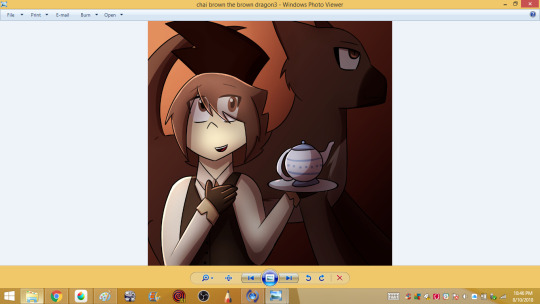
38. Which one of your OCs would be the best dancer?
I want to say Yang from DOTS: DD since he’s the one I jokingly said took ballet at one point in his life. Also I say jokingly because the dude was obsessed with rap music as a kid which probably doesn’t go too well with ballet. Aka kiddo Yang is based off of Abridged Jaden Yuki
39. Introduce any character you want

This is Omega!Nature. He’s a nature fairy from A Story Told and 100% done with everyone’s shit. He really hates humans but hangs out with two of them because he failed at doing a Fairy(tm) Prank on them. He’s an asshole and it’s charming because he looks like Tinkerbell’s emo phase mixed with the Onceler with the voice of Fidget from Dust: An Elysian Tail.
40. Any fond memories linked to your characters? Feel free to share!
I have very fond memories with Blake, Ruby, Cobalt, and Tigerlily from DOTS: DD, because they were my first original four characters I made back in 5th grade from a story I ended up continuing till this day! They had a lot of name changes, their first names have been Jaden, Jade, Chris, and Onishi, in that order. Because they’re my most developed four OCs, I have fond memories of seeing them grow into the characters they are now. Even if Blake somehow kept getting scrapped them coming back as an entirely new character. Huh.
0 notes
Text
Should Two Children Be Imprisoned For Plotting To Kill Their Classmates?
New Post has been published on https://kidsviral.info/should-two-children-be-imprisoned-for-plotting-to-kill-their-classmates/
Should Two Children Be Imprisoned For Plotting To Kill Their Classmates?
In Washington state, a 10- and 11-year-old were sentenced to years in a detention facility after being caught with weapons and claiming they were going to murder other kids at their school. Where is the line between a childish game and a real threat?
View this image ›
Illustration by Adam Setala for BuzzFeed
Colville is in Stevens County, far eastern Washington state. A town of 4,600 people, it is a roughly 12-block center where a scattered rural population can come for necessities before returning to farms and homesteads. There is a hospital, a post office, a courthouse, and a border patrol station, as the town is only 50 miles south of Canada. The proximity to the border, and its relative isolation, mean that visitors without clear business are likely to be regarded with some skepticism. Checking into the Selkirk Motel, out-of-town guests are asked their age, town of origin, and purpose of visit with open suspicion, and have their ID checked multiple times. The local drug trade suggests that this is not so extreme a precaution. In residential areas of Colville, the houses are uniformly one level, prefabricated, often in pastel shades of green, blue, and yellow. It is not unusual to see a deer wandering through the streets.
In this far-flung, sparsely populated, wintry town, Fort Colville Elementary is a hub of activity and color. In the entrance hall are bulletin boards with headings such as “Spotlight on Character,” “Principal’s Award,” and “Be a Buddy, Not a Bully.” A poster with a rainbow of columns declares the “Six Pillars of Character” to be trustworthiness, respect, responsibility, fairness, caring, and citizenship. The library is decorated with children’s drawings of their favorite books — Holes and A Pizza the Size of the Sun. Giant versions of origami cranes hang from the library ceiling. At reception is a rack of winter clothes under the “Coats for Kids” program, secondhand donations for children from poorer families.
Downstairs, near the fifth-grade classrooms, is the office of the school counselor, Debbie Rogers, and a paraprofessional in charge of discipline, Richard Payette, whom the children call Mr. Richard. (Many students also know him from Sunday school.) The room doubles as an indoor games area for children who might prefer not to be out on the playground, with Lego, Jenga, and board games, or for when it’s too cold to play outside. Rogers describes her role as “one part social worker, one part mom, one part counselor, and one part discipline.”
Guns are a fact of life in Colville. They are used in hunting season for deer, elk, and bears, as well as for fending off coyotes or cougars and protecting livestock. Even more normal for a child than packing a gun is carrying a pocketknife. Rogers says it’s not uncommon for a knife to be brought to school accidentally; they’re often used for farm work. The parents are informed, the weapon confiscated, and one such incidence of forgetfulness is tolerated.
Around 7:30 a.m. on Feb. 7, 2013, Payette went as usual into the lunchroom to supervise, greeted by the din of children eating breakfast and filing in from school buses. A fourth-grader approached him and said a fifth-grade boy, David, had had a knife on the bus, which he’d brought into school.
Payette searched David, his sweatshirt and pants pockets, but found nothing. The boy protested innocence: “Knife? I don’t know anything about a knife. You’re talking about a butter knife?’”
He then led the boy to the hall and opened his backpack, again finding nothing. He went into the classroom, and asked his teacher, Mr. Jones, if he could look through the student’s desk. Mr. Jones replied that David hadn’t been in yet but a boy named Adam — both boys have been given pseudonyms here — had, and the two had been spending a lot of time together lately. Payette took Adam’s backpack off the hook and opened it. Inside he found a knife with a 3-inch blade, a .45-caliber semi-automatic handgun, and a magazine containing seven rounds. That day, David was 11 and three months; Adam was 10½.
The police and the boys’ legal guardians were called. Officer Scott Arms of the Colville Police Department interviewed both boys, each in separate rooms, Adam with his father, David with his grandfather. Arms first asked David if he understood why he’d come.
David nodded and replied, “Because I was planning to kill a girl in my class.” He explained that the girl had been picking on him and his friends. The plan was for Adam to be the “shooter” and for David to be the “knifer.” Adam answered similarly, saying the girl had been rude to him and his friends. The officer felt both boys seemed without remorse or emotion. He pressed Adam, making sure he understood the implications of this, and Adam said, “Yes, I just want her dead.” (The boys’ confessions to Scott Arms were later ruled inadmissible at trial, as Arms did not explain to the guardian of either boy that it was they, rather than Adam or David, who were responsible for waiving Miranda rights.)
Adam also spoke with Debbie Rogers about the plot, expanding on the planned scale of the violence. “No, you don’t understand, there’s more to this,” he said. “There’s other kids, we were going to hurt other kids.” He told her some names, and then picked out more from a class list, six in all. Adam’s revelation about the horrific scope of the plan might have been a child’s honesty, but it might also plausibly have been empty, if unsettling, bravado. David chattered freely about his plan, as well as the physical threat he posed, on the day of his arrest (he tapped on the glass of the in-school suspension room to motion a detective closer, before informing him, “I just want to let you know,” as he raised his fists, “that I’m in tae kwon do and can really use my hands, and when you take me out of school you better put the handcuffs behind my back”), yet, unlike Adam, he mentioned only one intended victim in all of his interviews.
The district sent out an auto-call to parents. Teachers’ phones began ringing, emails piling in, parents arriving, some furious, some just wanting to speak to their child before afternoon classes, others to check them out for the day or for good.
When David’s grandparents and guardians Tamera and Gary were called to the school, Tamera presumed David had been injured on the playground, or that his bus had been in an accident. The scene that greeted them when they saw David detained was stark. “There was no chair, no desk, nothing in there,” says Gary. “It was a just a white room, with plastic walls and a door with a window in it. He’s sitting in there all huddled up in the corner.”
Tamera did what she could for David as she waited for her grandson to be taken to processing. “He had said he was hungry,” she recalls, “so I asked them, ‘Can I have his backpack? He has some snack food in his backpack.’ They said, ‘Sure, we checked the backpack, there’s nothing in there.’ I got the food out, gave it to him, gave him the book to read, said, ‘Go ahead and eat your snack, let’s read a book.’” She took the backpack home with her. Adam and David were then driven to juvenile processing and would be charged the next day with conspiracy to commit first-degree murder.
A few days later, she remembered the backpack, and went to clean it out: “That’s when I found the notes,” she says.
“Dear David
I’ll show you the steps and I ma have changed plans. So Just Read my steps and tell if Im right or rong.
how I got this
Step 1 we ride the bus.
Step 2 stay in class until I say.
Step 3 during frist recess we go to the bathroom and get are masks on.
Step 4 we boit out side and run tord her nad you, me kill her and get are Freedom.
Step 5 we run up to the upper field and run tord my house.
Step 6 if the cops catch us put your hands up and get ready for pan.[pain]
Step 7 Be ready to go to Jail.
Plese write back
P.S. we shoud do it on tomaro.”
When children plan out a murder step by wicked step — when they bring a gun and a knife and an ammunition clip to school and speak openly and plainly about their intentions — their judgment, rather than being an academic, psychological question, must be decided absolutely in a courtroom. Knowing or unknowing, scheming or confused. How do their upbringings, however good or bad, exculpate or implicate them? The state has to determine beyond doubt a 10- or 11-year-old’s capacity to fully understand their actions; an infinitely complex problem becomes a yes or no question. When a guilty sentence is handed down, as it was for both defendants in the Colville case, it is unclear whether it serves to rehabilitate, or merely punish.
View this image ›
Whether — and how — juveniles can be determined to be criminally responsible has a complicated history. One of the first modern lawyers to write about the legal status of children was the English politician and writer William Blackstone. In his Commentaries on the Laws of England, published in the 1760s, he argued that “the capacity of doing ill, or contracting guilt, is not so much measured by years and days, as by the strength of the delinquent’s understanding and judgment. For one lad of 11 years old may have as much cunning as another of 14; and in these cases our maxim is, that ‘malitia supplet aetatem’ [wickedness determines age].” Criminal court was the only suitable forum for such a child, even for a precocious 9-year-old, and penalties could be applied with the same readiness. Ten is still the age of criminal responsibility in England.
However, the United States’ first juvenile court, in Cook County, Ill., in 1899, was progressive and welfare-focused. The basis for the court was the doctrine of parens patriae, or parent of the country: Something had clearly gone amiss with the raising of a child if they were now on trial, and it was the duty of the court to remedy this with the attention and care of a benevolent guardian. In 1923, the Children’s Bureau published Juvenile Court Standards, expounding on these high-minded principles regarding the legal treatment of children. In each case there should be a “scientific understanding of each child,” that “treatment should be adapted to individual needs,” and “there should be a presumption in favor of keeping the child in his own home and his own community, except when adequate investigation shows this is not in the best interests of the child.” It was republished without alteration each year until 1954. By the 1930s, in most states, children could not be prosecuted in adult court until they turned 18, and in Arkansas, California, Colorado, Iowa, and Wyoming, it was 21. Parens patriae had triumphed.
In the 1980s, the national mood began to turn against treating all children as vulnerable, in response to a rapid increase in juvenile arrests and concerns over “superpredators” — hyper-violent children, beyond the reach of rehabilitation. In 1978, New York passed the Juvenile Offender Act, which allowed adolescents from 13 to be prosecuted for murder, and have the same sentence as an adult. The law is now similar for juvenile murder in Oklahoma, Illinois, and Georgia, with a lower limit of 10 in Kansas and Ohio. In the 1960s, the Supreme Court also made changes to ensure a more robust due process for juveniles, but this was still part of the shift toward making the juvenile system more like a criminal court. In nine states during the 1980s and 1990s (Arkansas, Georgia, Hawaii, Illinois, Iowa, Louisiana, Michigan, Missouri, and Rhode Island), legislatures gave juvenile courts a tougher mandate — to punish, to hold accountable, and at a younger age. Even when suspects are still tried as juveniles, the consensus became that it should be to mete out penalties that were proportional to suffering caused, rather than putting child development above all.
Under Washington law, children aged 8 to 12 are presumed to be incapable of committing a crime, and the burden is on the state to prove otherwise. Factors that must be considered in order to prove capacity include the nature of the crime, the child’s age and maturity, whether the child showed a desire for secrecy, whether the child admonished victims not to tell, and acknowledgment by the child that the behavior was wrong.
View this image ›
Illustration by Adam Setala for BuzzFeed
The Chewelah Casino is a low, hangar-like building in the midst of farmland, decorated with a pattern of glowing suns, and one of the few meeting places off U.S. Route 395 between Colville and Spokane. David’s grandmother and guardian Tamera is intelligent and engaging, but her voice radiates stress.
Gary sits beside her, a solidly built man with a thick gray mustache. He occasionally interjects to back up a point in a gruff, kind voice, less voluble than Tamera but no less shaken by David’s situation. Tamera speaks of David as a boy who doesn’t lie, who had no violent tendencies. He was a dreamer who loved fantasy games and make-believe, who still left baby teeth out for a dollar from the tooth fairy, who pet shelter kittens, who carried moths outside.
Gary and Tamera wryly describe their family setup as The Brady Bunch (Gary adds, “We just didn’t get the housekeeper”). Each had brought three children from their first marriages when they married in 1990. They’d nearly been empty nesters when Tamera’s daughter, who had a shaky grip on sobriety and lived with a meth-smoking partner, had been unable to care for her son. After four months, Tamera claimed custody. Grandparents becoming guardians is not uncommon in Stevens County, as parents in the intervening generation are lost to drugs and attendant problems.
Tamera and Gary had a knack for changing diapers and mixing formula, and a cheerful competence with raising babies, but took a refresher course in parenting trends they might have missed. They and David learned baby sign language, so that he could signal his needs, curtailing tantrums as he became a toddler. A psychiatrist at the trial later spoke of Gary and Tamera as “sensitive and motivated” in their caring for David and how the mix of experience and time had uniquely prepared them for this “re-parenting.”
David started school at Loon Lake Elementary, then moved to Valley School after third grade, for its better academics, and finally moved to Fort Colville Elementary, as Tamera worked at the Colville courthouse. David’s family lived just a few blocks from Colville’s Main Street, on a road lined with cedars. American flags were dotted on front porches and a tire swing hung above the lawn opposite. David began to be bullied, or at least excluded, by other children for the first time at Valley, and Tamera got a call from a parent of a friend of David, who had told her “he was so unhappy, he wished he would die.”
Tamera links some of David’s difficulty with his peers to having been raised “around adults.” “Things that children do — push each other, call each other names — he found that very hurtful,” she says. But at Fort Colville Elementary, he seemed happier, inviting 10 classmates for his birthday party at a bowling alley only three months before Feb. 7.
Adam’s situation was different. His family lived out of town, on an isolated road called Old Dominion. He had been homeschooled from first to third grade, but then entered Colville under difficult circumstances. A grandfather who lived with the family had recently died from kidney failure, and his father was frantically busy caring for a wife with progressive dementia, working as a driller, and keeping track of eight children, of which Adam was the youngest.
All of Adam’s brothers were known to law enforcement. Adam idolized his eldest brother, Eric, who had recently been sentenced to 25 years in prison for the murder of a 63-year-old in a botched robbery attempt. The brother closest in age to Adam, Andrew, seemed to regard Adam particularly as something of an apprentice. He would drive Adam around town, teaching him to case houses, look for bicycles to steal, find out if the family owned a guard dog. Earlier that school year, items had begun to go missing from Adam’s classroom. Some were hardly noticed: a library book, a textbook, a composition notebook. Then came iPods, backpacks, a flute, and a $695 clarinet. Debbie Rogers had Adam in her office for bringing a pint bottle of rum, one-third full, to school around the same time. She pressed him on the stealing, and he admitted it, saying the items were hidden under his bed. Andrew was selling them for him on eBay and had told him to take the instruments back to school, because they were too valuable.
Debbie Rogers was extremely concerned by Adam’s desire to emulate his siblings’ path, even before Feb. 7. “Adam kept saying over and over, ‘How do I go to jail, how do I go to jail, what do I have to do to go to jail?’” On July 25, 2012, having turned 10 a few weeks earlier, Adam was found in the parking lot of the Colville Walmart, in the driver’s seat of his family’s pickup truck. He admitted he had taken the car without his parents’ knowledge.
View this image ›
Illustration by Adam Setala for BuzzFeed
A week after the incident, a packed public forum was held in the Colville High School auditorium. The school board invited parents to share their reaction to the event, as well as suggest changes to school policy. Teachers stood on stage, fielding praise, blame, and general lingering anxiety. Several parents asked if teachers could carry concealed weapons into the classroom. The superintendent, Michael Cashion, replied that he would “entertain it as an option,” but also added that teachers might not be ready to undergo the training required to allow them to “level a weapon at a fifth-grader and shoot them.”
For weeks afterward, students were constantly coming to the counselor’s office, talking about the boys, or, more often, a memory it had prompted of violence at home. One third-grader at recess shortly afterward noticed a car parked near the playground with a few people sitting in it, and became terrified that they were waiting in the parking lot to kill him.
At a Feb. 27 school board meeting, Debbie Rogers, Richard Payette, and Justin Sanders, the fourth-grader who had told Richard Payette about David’s knife, were honored with a Colville School District Commendation Award. The gold-starred certificate praised his “acting quickly” and preventing “tragedy.” He was given a standing ovation and a golden apple.
“I was really proud of myself, and it was also kind of sad,” Justin commented in a bashful monotone as he was filmed by local news, rushing his words together as he repeated his story.
“The whole town is proud of this boy,” Principal Allen said. “Without his first step, we don’t know what would have been next.”
View this image ›
Illustration by Adam Setala for BuzzFeed
After spending two months in detention in Martin Hall, a facility for juveniles awaiting court appearances 20 miles southwest of Spokane, the boys appeared in court for a capacity hearing. They wore beige prison jumpsuits with handcuffs, a chain around the waist, and leg irons, which jangled as they took their seats. Adam was much taller than David, and very heavy-set, with the frame of an adolescent, but far less confident in conversation than his friend. A mop of lank blond hair fell forward into his eyes. David was brown-haired, skinny, and long-limbed.
The state, led by prosecutors Lech Radzimski and Tim Rasmussen, laid out an aggressive case for the capacity of the two boys at the time of the conspiracy. Their contention was that the “taking of another human being’s life is intuitively wrong” and a boy “of any thinking age” knows its seriousness. (The incriminating statements the boys made to Officer Arms were allowed in at the capacity hearing, potential Miranda violation notwithstanding.) As for secrecy, a third student, Chase Lee (also a pseudonym), had been aware of the boys’ plan, and had been promised $80 not to tell anyone.
Both boys’ family histories and discipline records were pored over in the courthouse — they included missing homework, swearing at recess, lateness to class, pushing two girls into a snowbank, and an incident in October 2012 when Adam, David, and two other boys had put a jump rope round a girl’s waist and pulled her across the playground, “scaring her to the point of tears.”
The idea that David’s discipline records somehow related to her grandson’s ability to stand trial for a murder conspiracy incenses Tamera: “I mean, he had late homework in the fourth grade — most fourth-graders have late homework.”
Two experts who interviewed the boys also testified. Many anticipated their perspectives would exonerate them; this was not the case.
Psychologist Dr. Clark Ashworth stated that both boys were aware of what they had been planning to do, and what its implications were. Adam understood his actions were wrong, Ashworth said as an example, because of his acceptance of the possibility of jail time. He had said: “We’ll probably go to juvy like a year or two or something. I wouldn’t go for a death sentence because nobody got hurt.”
The boys also talked to Ashworth about a sexual component of the plan. He had asked about the seriousness of what landed his brother in prison and Adam responded that murder is “the baddest crime that I know of.” Adam then said that a worse crime would be to “kill a girl and then rape ‘em.” David confirmed this, and when asked to define rape, said, “It’s forced sex. It’s not about sex, it’s about strength … It’s illegal.”
Psychiatrist Dr. Alan Unis, with more qualifiers, broadly agreed with Ashworth’s opinions. He felt that Adam’s abilities, which were average at best, had been impeded by being educated in a home while his mother was neurologically deteriorating. Adam’s writing was particularly telling, he said: “One of the things that helps us think in a sophisticated way, analytically, critically, is when we write things down … This boy’s written language is appalling.”
Unis questioned Adam’s ability to comprehend his own plans or consider their consequences. Adam had also voiced the strongest expression of remorse to be heard from either boy to Unis, saying, “There isn’t a day that goes by that I don’t think about what I did, and I play it over and over in my head and I wish I could have the opportunity to tell those people how sorry I am.” Unis granted the possibility that Adam was “prompted” but averred, “It came out very, very spontaneously, and it sounded sincere to me.”
David was hyperactive and verbose in his interviews. He swore, spoke at a rapid clip. His opener to Ashworth was, “Well, I can kick back and laugh. What do you want me to talk about? If you need me to talk about the events that happened a few days ago, I’m all ears and mouth.” When asked if he had told his grandparents about the plan, David said he hadn’t, “‘cause they would tell me not to kill, but I don’t want to listen to all that student speech about killing is wrong, you’ll be arrested. I don’t give a crap.”
Ashworth said he seemed to be manic. When showed police photographs of the school and weapons, David expressed disappointment at there not being a photograph of the knife, as that had been his — blue-black with a spider design on the grip. When Ashworth asked David whether it was a good enough reason to kill the girl because she was annoying, he replied, “Well, the way the other boy and I see it, but you don’t, no.” He said the plan was “actually good to me, and bad, but mostly bad for the real world cause I had a feeling that I’d get arrested.”
Dr. Unis also spoke of David’s mania, saying, “He had a lot of the symptoms we see in kids with bipolar mania … an inappropriately bright, happy mood, incessant motor activity, expansiveness, grandiosity. And then the rapid speech, and of course the problems with sleep.” Unis underlined that one of the factors most in David’s favor was Gary and Tamera’s devotion, but added that in the four months before his grandparents took custody of David, there could have been circumstances beyond their control.
David’s mother is on a battery of prescribed psychiatric drugs, including Abilify, Lexapro, Trazodone, and oxycodone. Tamera recalls there were no such pharmaceutical safeguards in place when her daughter dropped David off with her in 2001: “She was untreated bipolar at the time. She just couldn’t handle raising a baby because babies, they cry and they make noise and they’re messy and they require you to give up sleep and they require you to — you know, at that point in her life, she could not. And she was in a bad relationship, there was some domestic violence. And she called me and said, ‘Can you come get him?’ She had some serious health issues going on. It was a lot of things with her all at once.”
David’s paternal grandmother, Meri, also submitted a letter to the court about her son, Gordon, David’s father, and his extensive mental health history. Gordon had been in and out of psychiatric facilities and threatened suicide even before adolescence; by 28 he was dead of what Dr. Unis euphemistically called “the consequences of untreated bipolar illness.” Unis stressed the increased likelihood of David having a bipolar disorder. He said one parent with the illness increased the chance of a diagnosis for the child tenfold, and two equaled “a grave risk.”
Judge Nielsen summed up the capacity hearing by stressing its uniqueness in Washington state law. Boys this young, with unbroken voices, a crime this serious, with a planning phase for weeks ahead of time, was horribly exceptional. But the evidence was weighted to suggest their understanding of the crime, and of the finality of death. There had been no intimation by either boy that there would have been a last-minute course reversal, and that, if Payette hadn’t found the knife and pistol, the plan would have gone ahead, clumsy, short-lived, but nonetheless lethal. Capacity had been found, and the boys were fit to stand trial.
View this image ›
Adam’s case was settled in just over a week with a guilty plea — his lawyer, Helen Dee Hokom, did not visit Adam in detention prior to making this decision, did not attempt to raise a mental health defense or to suppress any evidence. The sentencing hearing came a month later.
Dr. Kevin Heid, a pediatric psychologist called by the defense, spoke out in favor of leniency. Adam was impressionable, damaged, and desperately sought out a sense of belonging, with a dearth of reliable adult figures in his life. Juvenile detention would introduce him to experienced criminals, antisocial personalities, and generally lost adolescents. “Adam did not have the cognitive ability to problem-solve his way out of the plan. That would be a concern, but that is different, I believe, than a morality issue, or an empathy issue, or an antisocial issue. It is a cognitive issue,” Heid testified. The reality was that the psychiatric hospital setting Heid wished for his patient was simply not a funded option within the Washington system. Treatment would have to be at a juvenile detention facility, not in a clinic or the community.
The prosecution invited Tracie Case, the mother of the intended victim mentioned in the note, to speak. Her husband stood behind her with an arm on her shoulder. She addressed herself to Adam, who was sitting a few feet away with his lawyer, handcuffed.
“She loves horses and the color pink,” Tracie said of her daughter, her hands clasped and her voice tremulous. She maintained steady eye contact with Adam. “She wants to get married and have kids of her own, and to be a famous pastry chef when she grows up. And if you two boys had had your way, she would have never grown up. She would never have had the chance to make her dreams come true.”
“You were willing to take that away from her, take her away from me,” she continued. “Life is all about choices. We make good or bad. There are consequences, and you have to pay those consequences.” She was nearly overwhelmed with tears by the time she folded her statement and stepped down.
The standard range for a conspiracy to murder charge for a juvenile is two years, but prosecutor Rasmussen was pushing for a sentence between five and six years, meaning until Adam is 16. His rationale was that by then there would be no question that Adam could be prosecuted for other crimes as an adult.
“Adam is dangerous because he doesn’t feel toward other people the way most boys do,” he argued. “There is something missing in him.” He spoke of the “evil” in Adam’s heart that day, and commented derisively on the parade of experts the court had seen: “All of these people concentrate on what Adam needs and what can be done for him to help him understand what he did was wrong. He already understands that it’s wrong to kill a person, he was just going to do it anyway.”
Finally it was Adam’s turn to speak for the first time. He was already crying as he stood: “Like my dad said, I’m sorry, and I’m also sorry because I know this is a bad thing that I’ve done,” he sobbed as his voice trailed off. “And, that this…is not a usual thing for a person my age to do…”
The judge, in a quieter voice, thanked Adam, saying he appreciated the difficulty of speaking up. In his sentencing, Nielsen acknowledged the many, many stressors on Adam’s life, and his extreme youth. But whatever the childish, nonsensical, unworkable aspects of the conspiracy, a substantial step had been taken toward the plan when Adam zipped his gun into his backpack, and hid David’s knife alongside. Nielsen issued a ruling of a minimum of 168 weeks, or three years, up to a maximum of 260 weeks, or five years, keeping Adam in detention potentially until the end of his junior year of high school.
View this image ›
Tamera was determined to take David’s case to trial. In the meantime he was held at Martin Hall, where he was placed often in solitary confinement. After four isolated months, Tamera says, “he started showing psychoses, he started seeing things that weren’t there, he would hear voices.” On June 18 she decided to post his $100,000 bail — a figure she found outrageous. “We have an 11-year-old child who has no money, he has no car, he has no bicycle, he has a skateboard, that’s his only method of transportation other than me, and they won’t lower his bail.”
She homeschooled David as they awaited the trial. In September, she and Gary moved to Chewelah, midway between Colville and Spokane. The move was partly so the court might be more likely to allow David to go on trips outside the home.
Throughout our conversations, Tamera has remained tough, but her composure breaks as she talks about David’s bail conditions: “I had asked them if I could take him on. I said, if this is all the time I have with him now, for three or four years, I want to do some things with him. Take him fishing, go to Silverwood, which is an amusement park just over the border in Idaho, and they said no, that he was a flight risk.”
The trial might result in more unpleasant facts on the record but it would also mean a full hearing for David on a mental health and immaturity defense, without being lumped together with Adam. It meant another psychologist would have time to evaluate David, and Tamera bailing him could ensure his care, as well as show the court that David being out of custody for months at a time was no threat.
Both his grandparents and his lawyer wished to show that David was a sensitive boy given to daydreaming and alter egos, detached from reality, not to be held accountable for when games spun beyond his control. This tendency to imagine and invent was only compounded by the bipolar diagnosis that had emerged from his scattered energy, and rapid-fire responses, in the earlier psychiatric interviews.
“He’s not a normal 11-year-old boy,” Tamera says to me, carefully. “He doesn’t live in the real world, he has his own little world that he’s in, and he connects with our world but he’s not in it.”
The prosecution did, of course, present more damning testimony at the trial that October, like from Chase, the boy David and Adam had intended to bribe. Chase shuffled closer to the microphone than other witnesses, speaking softly. He proceeded to tell the court everyday details of fifth-grade friendship (“I never hanged out at their houses”), mixed in with unnerving detail of the plan all narrated in the same wrenchingly matter-of-fact, childish voice. For some weeks Chase had known of the boys’ plan to get revenge: “I’m pretty sure he mentioned handcuffs and raping … He just told me that he was going to use handcuffs the day before. He explained rape was getting somebody naked purposely.”
On the morning of Feb. 7, Chase came in from the bus with David and Adam, who passed a knife back and forth, which Adam then slipped into his sweatshirt pocket. Chase earnestly testified that as he walked to class with Adam and an ebullient David, he had apparently told David to “come clean and stop doing what he was going to be doing.” He claimed David shrugged him off, saying, “No, I want to go through with this.”
Melody Youker, a case manager at Martin Hall, also testified. She spoke with amused affection of David’s hyperactive persona, and said that when he first arrived, he “kind of bounced around, rattling on the doors. Seemed pretty upbeat.” She also revealed that, on the day he spoke to Martin Hall at his intake assessment, David had reeled off, unbidden, incriminating throwaway lines. He asserted that if he found out who “snitched” on him, he would kill them, and that he was having “a day,” because he was here and the girl was still alive. He also boasted that he had been “the brains of the operation.”
However, when cross-examined by Donald Richter, David’s attorney, Youker showed she could be an asset to the argument that David was a dreamer, in the grip of a manic episode, utterly incapable of distinguishing between fantasy and reality. She described David as having great difficulty focusing, and generally summed him up as an unusually hyperactive, intelligent bookworm. David also liked playing characters, in a way that most children his age had grown out of; particularly he wanted to play any character “with a sword.”
Youker testified that in May, David had told her he had a secret, and that if he told her, she couldn’t tell anybody: “And so he told me that when he goes to sleep at night, he leaves his body and goes into his wolf body. And he was concerned — he wanted help with this, because the wolf body was getting out of control. And he wanted to be able to control this wolf body.” As Melody explained this to the court, David began to drum his fingers on the desk, continuing throughout the rest of her questioning, and stared hard at the witness box. David had also told Youker that when he speaks to someone new, he sees words and numbers hovering around them, telling him what they’re about and how far he can trust them. Youker’s number was high, around 698.
Youker’s testimony also touched on how isolated David had to be kept in Martin Hall, due to his small stature, outsized estimation of his own strength, and how ill-disposed other inmates were to an upstart, precocious kid, lost in his own world.
View this image ›
Illustration by Adam Setala for BuzzFeed
Jerrie Newport, a juvenile probation counselor for Stevens County, drew up a report that was intended as a balanced look at the perspectives of all adults in the case, and to guide the court in its sentencing. Newport revisited Unis and Ashworth, who reiterated David’s likely bipolar disorder, and the need for lifetime mental health treatment. The most damaging assessment of David in the report came, in fact, from Newport herself, perhaps all the more damning because it was a lay opinion, in persuasive prose, that amounted to a woman who had been thoroughly unsettled by a boy she regarded as dangerous.
Newport had been charged with seeing David once a week while he was on bail, accompanied by his grandmother. Most weeks were uneventful, but on Sept. 19, Newport noted an incident that unsettled listeners. Tamera spoke to Newport about plans they had when David got home, at which point David slammed his palm to his forehead and said loudly, “What the…!”
Tamera calmly asked David what he intended to do, and in a low, warning voice, David replied, “Going back to sleep.” He followed it with, “When I get home I am going to break something.” When Tamera asked what, he replied, “Something I can break. Like a box.” She offered that she had a box he could vent his frustration on if that’s what he wanted. With his head lowered, David looked up at Tamera through his eyebrows and said — in court, as Newport related the story, she adopted a flat, affectless, Village of the Damned tone — “Well, excuse me, but could I borrow a knife?”
Judge Nielsen stated that he accepted David’s bragging assertion at Martin Hall, of being “the brains.” That he was “a leader, charismatic.” He returned to the doctors’ suggestions, that detention, if coupled with treatment, would mean not only community safety and “possibly punishment,” but an improved prognosis, rehabilitation. He spoke warmly of David’s grandparents, singling out Tamera as a “thoughtful person, highly skilled,” but that he feared she could not always be there to curb David’s more worrying instincts. Though he admonished, “I don’t, in saying all this, mean that David is an evil person, I don’t believe that for a minute.” He understood David’s grandparents wanted to continue to raise him, “but I have to weigh things here as a judge in the middle of a community.” Nielsen finally handed down a sentence of three to six years, meaning David would also possibly be held until his junior year.
View this image ›
Via youtube.com
In February 2014, though, Adam was re-sentenced. The court agreed with an appeal filed that his first lawyer had been incompetent, violating his due process rights, that Adam had not properly understood the consequences of his plea bargain, and that his capacity was far more in question than had been previously argued. The sentencing focused heavily on Adam’s exemplary behavior while at the detention center for convicted juveniles, Echo Glen, and brought out fully what had been expressed to me by everyone I interviewed: that Adam was a follower, that he would never have been inclined to violence on his own. His counselor testified that everyone at Echo Glen loved him there and recognized his smile. Debbie Rogers and Richard Payette spoke in Adam’s favor, as did Superintendent Michael Cashion, who said, “Colville schools are ready to serve Adam, whether it be tomorrow, or a year from now,” the “tomorrow” part of which somewhat surprised the courtroom. Adam’s sentence was altered from a maximum of 260 weeks to 129 weeks with 36 months mandatory probation, meaning he could be released by 2015.
It’s yet to be seen whether Colville, and the boys, will be best served by the earlier release of Adam, and the potential six-year detention of David. Adam appears to be thriving at Echo Glen. As he told the judge, he has moved on to the “seventh- and eighth-grade math books.” When he’s released, he will be returning to a house in which a brother who trained him in thieving still lives, and where for six years he was cared for and then homeschooled by a mentally declining mother. However, Adam’s father, who leaned over the bench at his latest sentencing to say, “It’s up to you now,” loves his son, and wants him home.
There is another unanswered question, which underlies the entire case against Adam. It was never clear why the Stevens County welfare and education system was satisfied keeping Adam off the books and being “taught” at home, why at a time crucial for his development he was out of public school for three years, left with an unwell parent. If an attitude of parens patriae had been adopted far earlier, Adam might have been saved three lost years before Fort Colville.
But is it best, then, for a boy like David, who, the court now seems certain, devised the plan, to spend time in a facility with other, older children with multiple offenses? Should he in fact be kept at home in Chewelah, with Tamera and Gary, who would adhere to suggested therapy, a behavioral or medical regime? But then there would be no proportionate punishment, no consequences. As prosecutor Rasmussen put it, “I don’t have much faith that he will be successfully treated … We will see him again when he gets out.”
View this image ›
Echo Glen is a dot in the eastern Washington wilderness, the nearest landmark a body of water called Icy Creek. It is a one-hour walk to the nearest town, three hours to the highway. Tamera tells me David was supposed to be housed with smaller, younger inmates, but in fact only one dormitory matched this description, and Adam was there, so to keep the boys apart David had to bunk with offenders who were 15, 16, and 17, whom she describes as being “as large as full-grown men.” There had been violent fights in the dorm, though none yet that had targeted David. Tamera’s voice rises in exasperation: “I figure in this country if we’re going to start arresting 10- and 11-year-old babies then we either need to build separate facilities for them, to not put them in with the bigger kids, or we need to not arrest 10- and 11-year-old babies.”
A counseling program that had been promised began five months after David’s arrival, and would last only 10 weeks, due to lack of funding. Tamera and Gary see him every other weekend, for a total of four and a half hours. Recently a staff member, in response to David’s resolute attachment to his fantasy world of wolves, swords, and quests, and his perceived distance from the other inmates, had made the decision to take away his books, Legos, a 500-piece wolf puzzle, and a Star Wars poster. When Tamera asked whether this was a disciplinary move, she was told no, that David simply spent “too much time” in his imagined world, and that he “wouldn’t come out and play with the other boys” — no mention was made of the four- to six-year age gap between him and his roommates, or the willingness of other inmates to engage with David. Tamera says, shakily: “It’s really hard to know someone is mistreating your child, and you are completely powerless to do anything about it.”
While bailed out, Tamera tells me, David played with neighbors’ kids, saw his old baseball coach, and studied. Tamera also saw the whole case against her grandson, the beginning of criminal proceedings in the first place, as deeply flawed, mistaking a child’s hare-brained imaginings for a sinister plot.
“It’s not really a credible threat,” she says. She later adds, “You’ve got two boys going, ‘I’m the tough guy, I’m the boss.’ Of course, they’re 10 and 11 years old — they’re both going to say that. I don’t think either one of them felt they could back down, ‘cause they didn’t want to wuss out in front of the other. So nobody said, ‘This is dumb, we’re really not going to do this, we’re just pretending.’”
Sign up for our BuzzReads email, and you’ll get feature stories like these in your inbox every Sunday!
View this embed ›
Read more: http://www.buzzfeed.com/victoriabeale/should-two-children-be-imprisoned-for-plotting-to-kill-their
#colville#conspiracy to commit murder#fort colville elementary#juvenile delinquents#washington state
0 notes